

Pop Art – The Fusion of High Art and Popular Culture
In the 1950s, international art did a sudden and unexpected 180-degree turn. In the United States and the United Kingdom, a new art movement, pop art, began to grow in popularity. This new art movement took inspiration from the often mundane, consumerist, slightly kitschy, and mass-produced parts of popular culture. Pop artists like Andy Warhol, Richard Hamilton, and Roy Lichtenstein instigated a shift in our conception of high and low art forms. These artists drew attention to the growing consumerism in the markets and our art consumption.
Table of Contents
- 1.1.1 What Makes Art Fine?
- 1.1.2 Shocked Withdrawal or Cool Acceptance?
- 1.1.3 How Does Pop Art Explore Cultural Trauma?
- 1.1.4 Capitalist Critique or Enthusiastic Endorsement?
- 2.1 Proto-Pop Art
- 2.2.1 Finding a Pop Art Definition
- 2.3.1 Establishing American Modern Pop Art
- 2.4 American Pop Art versus British Pop Art
- 3.1 The Tabular Image: Eduardo Paolozzi and Richard Hamilton
- 3.2 Pulp Culture: Roy Lichtenstein
- 3.3 The Monumental Image: James Rosenquist
- 3.4 Repetition: Andy Warhol and Repetition
- 3.5 Pop Sculpture: Claes Oldenburg
- 3.6 Pop Art in Los Angeles
- 3.7 Signage: Ed Ruscha
- 3.8 French Nouveau Réalisme
- 3.9 German Capitalist Realism
- 4.1 Eduardo Paolozzi: I was a Rich Man’s Plaything (1947)
- 4.2 Richard Hamilton: Just What Is It That Makes Today’s Homes So Different, So Appealing? (1956)
- 4.3 James Rosenquist: President-Elect (1960-61)
- 4.4 Claes Oldenburg: Pastry Case, I (1961-62)
- 4.5 Roy Lichtenstein: Drowning Girl (1963)
- 4.6 Sigmar Polke: Bunnies (1966)
- 4.7 Ed Ruscha: Standard Station (1966)
- 4.8 David Hockney: A Bigger Splash (1967)
- 4.9 Andy Warhol: Campbell’s Soup I (1968)
A Brief Summary of the Pop Art Movement: What Is Pop Art
Many of us know artists like Andy Warhol, but what is Pop Art as a movement? When it comes to creating a Pop Art definition, we need to consider the type of Pop Art. There is some contention surrounding the original birthplace of pop art. Similar trends began appearing in England and America in the early 1950s. Pop art was a real 180-degree turn in the development of modernism from the Abstract Expressionist movement that came before it.
The Pop Art definition turned to tangible and accessible parts of popular culture as inspiration, replacing the traditional “high art” themes of classic history, mythology, morality, and abstraction. Pop art elevated the more mundane parts of popular culture to fine art, and today it is one of the most recognized modern art styles.
Key Pop Art Ideas
Pop Art may appear more trivial and superfluous than other traditional fine art movements. The bright colors, use of popular imagery, basic shapes, and thick outlines may suggest a more playful form of art, but the Pop Art movement is packed with underlying intricacies and social commentaries. Here is a little Pop Art background.
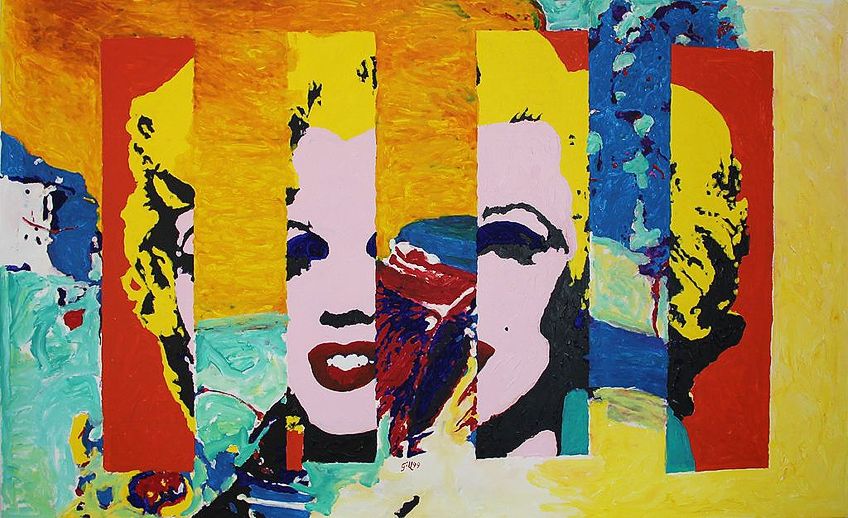
What Makes Art Fine?
The most prominent idea within the Pop Art movement was to blur the lines between what had previously been considered fine art and the more kitschy, mundane parts of popular culture. Pop artists celebrated items of consumerist value, insisting that there is no cultural hierarchy when it comes to worthy subjects of artistic creation. Pop artists borrowed inspiration from any source, regardless of cultural value.
Shocked Withdrawal or Cool Acceptance?
The works of Abstract Expressionist artists are typically highly emotive. In contrast, Pop Art paintings and collages tend to be more removed and distant. Although Pop artworks often explore diverse cultural attitudes and integral parts of social life, they do so in a cool and relatively unemotional way. Art historians have hotly debated whether this distance is a shocking withdrawal from the cultural themes that Pop Art explores or whether it is the opposite. Perhaps the coolness reflects an acceptance of popular culture.
How Does Pop Art Explore Cultural Trauma?
An integral part of the Abstract Expressionism that preceded Pop Art was the search for trauma within the soul. Pop artists searched for the same soul trauma, but on a cultural level. In Pop Art, the worlds of popular imagery, cartoons, advertisement, and cultural phenomena like the boom of fast-food restaurants would mediate this social trauma.
In Pop Art, all these manifestations of a cultural trauma are significant, and they give the artist unmediated access to the deeper concerns of humankind.
The modern world is characterized by unmediated access to almost everything. From the built environment to the personal lives of celebrities, everything is available for consumption and critique. Pop Art reflects this access, drawing together various cultural elements to demonstrate that everything is connected.
Capitalist Critique or Enthusiastic Endorsement?
In England in particular, Pop Art artists embraced the media and manufacturing boom of the Second World War. Many view the wide use of commercial advertisement in Pop artworks as an endorsement of the capitalist marketplace. Some critics believe that Pop Art celebrates the growing consumerism of the modern age.
Others find an element of cultural critique buried within these multi-layered works. Pop artists elevated commonplace commercial objects to the status of fine art. By equating commercial goods with fine art, Pop artists draw our attention to the fundamental fact that art itself is a commodity.
Many Pop Art artists began as commercial artists. Ed Ruscha was a graphic designer, and Andy Warhol was also an incredibly successful magazine illustrator. Thanks to these early beginnings, these artists demonstrate fluency in the visual vocabulary of popular culture. These skills eased the ability of these artists to blend fine art and commercial culture seamlessly.

The Origins of the Pop Art Movement
The Pop Art movement is interesting because it developed simultaneously in the United States and England. The first sparks of the Pop Art movement were vastly different in each of these countries. As such, it is essential to begin considering them separately.
In the United States, Pop Art was a return to more representational art that used the irony of mundane reality to neutralize the personal symbolism of Abstract Expressionism. In contrast, early British Pop Art was more academic. British Pop artists used irony to explore and critique the explosive consumerism of post-war American popular culture.
Proto-Pop Art
While the 1950s saw the beginning of American and British Pop Art, some European artists like Marcel Duchamp , Many Ray, and Francis Picabia predate the movement in their exploration of capitalist and modernist themes and styles.
Some American artists hinted at the development of modern Pop Art as early as the 1920s. Artists like Stuart Davis, Gerald Murphy, Patrick Henry Bruce, and Charles Demuth created works that explored imagery from popular culture, including mundane commercial objects and advertising design.

The Independent Group: Pop Art in Great Britain
In London, the Independent Group of Artists was formed in 1952, and many consider this group to be the precursor to the new Pop movement. This gathering of young painters, sculptors, writers, architects, and critics hailed in the new Pop Art movement. This group of artists began meeting regularly in the 1950s and their discussions would center around developments in technology and science, the found object, and the place of mass culture in fine art.
Some notable members included the architects Peter and Alison Smithson, Richard Hamilton, Eduardo Paolozzi, and the critics Reyner Banham and Lawrence Alloway. As these creatives began meeting in the 1950s, England was still gradually recovering from the post-war years, and much of the population were ambivalent about the popular culture in America.
The Independent Group shared this hesitancy towards the commercial character of American popular culture, but they were enthused about the rich world of pop culture, discussing science fiction, car design, Western movies, rock and roll music, billboards, and comic books at length.
1960 saw the first influences of American Pop in the Royal Society of British Artists’ annual young talent exhibition. By January of 1961, R. B. Kitaj, David Hockney , Joe Tilson, Billy Apple, Dereck Boshier, Peter Blake, Patrick Caulfield, Allen Jones, and Peter Phillips were planted firmly on the Pop Art map.
Billy Apple was responsible for designing the invitations and posters for the following two annual Young Contemporaries exhibitions. In the same year, Blake, Kitaj, and Hockney won prizes in Liverpool at the John-Moores Exhibition. During the 1961 summer break at the Royal College, Hockney and Apple visited New York together.

Finding a Pop Art Definition
When it comes to deciding who was the first to use the term “Pop Art”, there is a great deal of contention. In Britain, there are several possible sparks that led to the actual “Pop Art” term. Peter and Alison Smithson used the term in a 1956 article published in Ark Magazine. The article was called “But Today We Collect Ads.”
Richard Hamilton defined Pop in a letter he wrote, and Paolozzi also used the word Pop in his I Was a Rich Man’s Plaything (1947) collage. John McHale’s son also believes that his father first used the term while conversing with Frank Cordell in 1954.
Lawrence Alloway is also often credited with first using the term in his 1958 essay, The Arts and the Mass Media. In this essay, however, he only uses the phrase “popular mass culture,” and he was referring to popular culture as products of mass media rather than works of art. In 1966, Alloway clarified these terms, but by this time, Pop Art had already made its way into schools and galleries.
America Pop Art Background
New York City was the birthplace of American Pop Art. In the middle of the 1950s, New York artists approached a significant crossroads in the development of modern art. In America Pop Art Artists could either follow in the footsteps of the Abstract Expressionists, or they could rebel against the formalism of modernist schools of thought. Naturally, many artists chose rebellion, and they began to experiment with non traditional forms and materials.
At this time, Jasper Johns was already causing a commotion with his abstract paintings referencing objects that “the mind already knows.” These objects included numbers, handprints, flags, letters, and targets. Other Pop Art artists like Robert Rauschenberg were using found images and objects alongside traditional oil paints. In the same way, the Fluxus movements and Allan Kaprow chose to include elements of the world around them in their artworks. Alongside others, these artists would later form the Neo-Dada movement.
Although Pop Art began emerging in the United States in the early 1950s, it was in the 1960s that the movement gained traction. At the Museum of Modern Art in 1962, Pop Art was introduced at a Symposium on Pop Art. As artists began to use advertising elements in modern art, commercial advertising began to incorporate elements of modern art. American advertising became very sophisticated, and American artists needed to find more dramatic styles to distance themselves from mass-produced materials.
While British Pop Art took a slightly humorous, romantic, and sentimental approach to American popular culture, American artists produced Pop Art that was typically more aggressive and bold. The British were distanced from the realities of American consumerist images, whereas American artists were bombarded with them daily.
Establishing American Modern Pop Art
Robert Rauschenberg took a great deal of influence from Dada artists, including Kurt Schwitters . Rauschenberg believed that painting relates both to the worlds of fine art but also everyday life. This opinion challenged the dominant modernist perspective of the time. Rauschenberg combined pop culture imagery and discarded objects in his work. In this way, Rauschenberg could draw a connection between his work and topical events in American society.
The silkscreen paintings that Rauschenberg completed between 1962 and 1964 combined magazine clippings from National Geographic , Newsweek , and Life with expressive brushwork. Rauschenberg’s early work is often classified as Neo-Dada because it is distinct from the American Pop Art style that flourished in the 1960s.
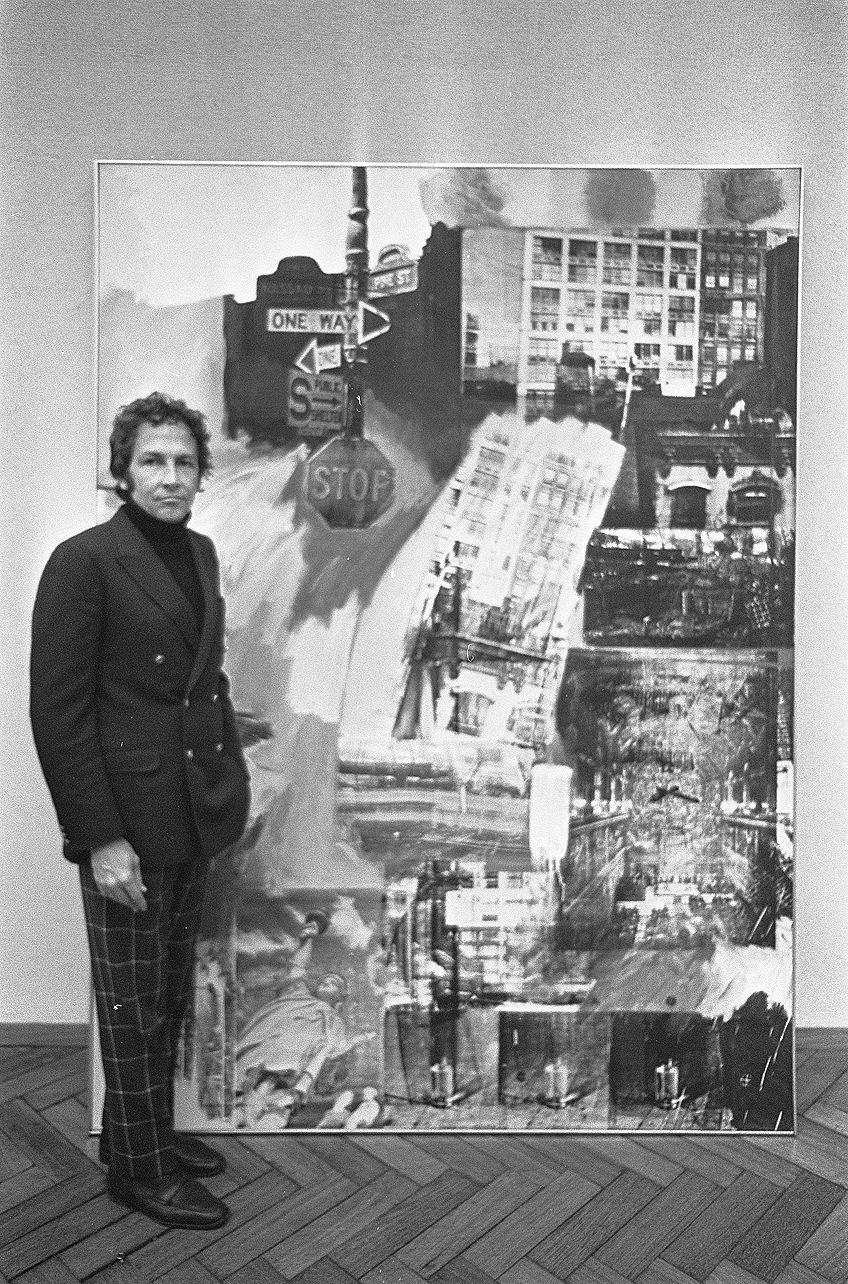
When it comes to prominent American Pop artists, we cannot forget Roy Lichtenstein . Lichtenstein’s use of parody in his works offers perhaps the best definition of Pop Art’s underlying premise. Lichtenstein produces precise, hard-edged compositions based on old-fashioned comic strips.
Using Magna and oil paints , Lichtenstein would appropriate and alter scenes from DC comics and others. It is easy to recognize the work of Lichtenstein by his use of Ben-Day dots, bold colors, and thick outlines. The artist effortlessly blends popular culture and fine art, integrating irony, popular imagery, and humor into his works.
American Pop Art versus British Pop Art
Pop Art emerged in both America and Britain at around the same time in the 1950s and 60s. The overarching Pop Art style is an amalgamation of the differences between the two nations. Although both countries found inspiration in the same subject matter, there are several distinctions between their styles.
The early British Pop Art found its inspiration in viewing American popular culture from a distance. With this distance came a certain level of romanticism and sentimentalism, as well as a significant amount of disdain.
British Pop artists took an academic approach to American popular culture, dissecting the power of American popular imagery in manipulating the lives of its citizens. The traditionally dry British sense of irony and parody seeped into British Pop Art.
American Pop artists, by contrast, lived and breathed American popular culture, and this lack of distance is apparent. American Pop Art was also, in part, a rebellion against other forms of modern art. Abstract Expressionism was the greatest impetus for American Pop artists, who wanted to move away from the highly emotive and personal symbolism of the style. As a result, American Pop artists use mundane, impersonal imagery in their works.
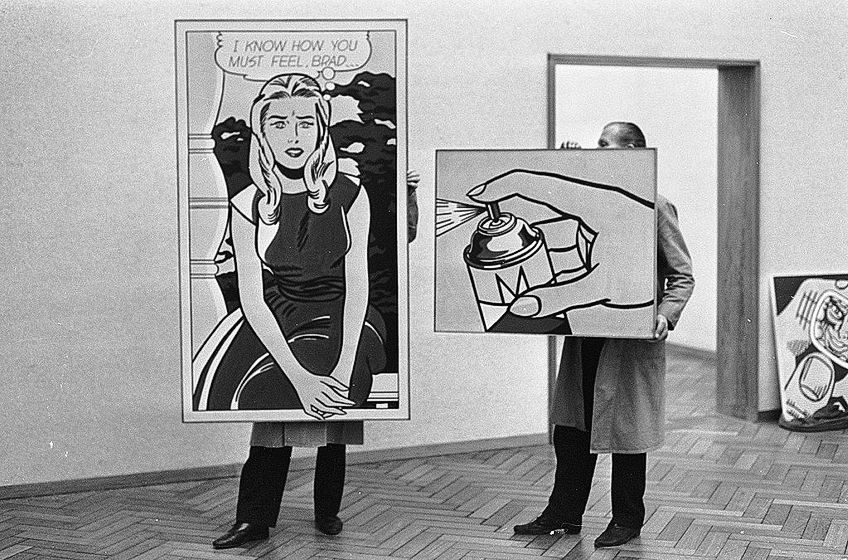
Trends, Concepts, and Styles in Pop Art
Following the transition from Neo-Dada to Pop Art, artists throughout the world became increasingly interested in using popular culture in their works. While members of the Independent Group were the first to use the term “Pop Art,” American artists quickly gravitated towards this new style.
Although the individual styles of Pop artists vary greatly, there are common underlying themes and concepts to the Pop Art movement. The use of imagery from popular culture is the most prominent feature throughout Pop artworks.
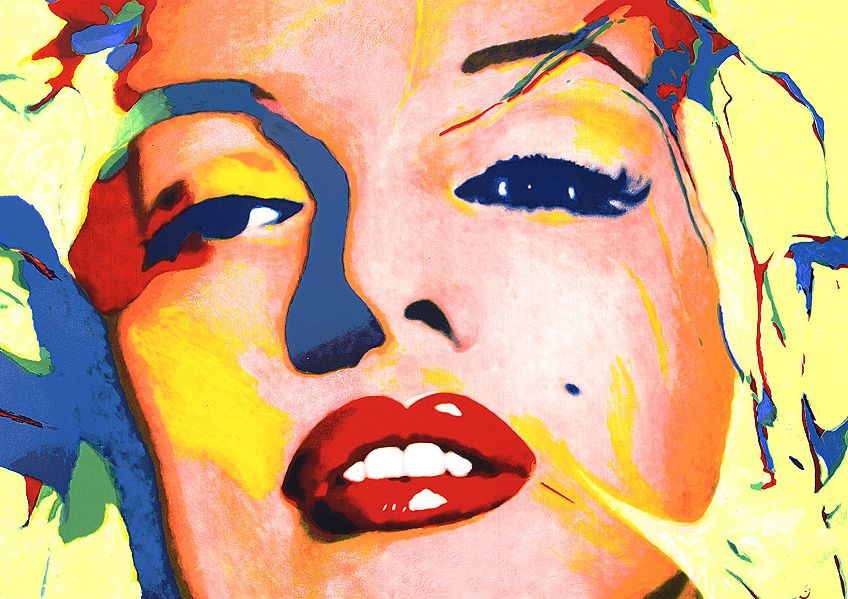
After the Pop Art movement took off in America, several European variants began emerging, including the German Capitalist Realist movement and the French Nouveau Réalisme.
The Tabular Image: Eduardo Paolozzi and Richard Hamilton
European Pop artists maintained mixed feelings towards the popular culture of America, and these feelings are perhaps best conveyed through the Pop Art collages of Hamilton and Paolozzi. The artists simultaneously criticized the excess and exalted the mass-reproduced objects and images.
Members of the Independent Group, including Hamilton, were among the first to use mass media imagery in their works. Just what is it that makes today’s homes so different, so appealing? , a 1956 collage by Hamilton, combines carefully sourced elements from mass media imagery to convey his belief that American culture was one of excess. Paolozzi dissects the barrage of mass media through his photo montage collages, like his 1947 work, I Was a Rich Man’s Plaything.
Pulp Culture: Roy Lichtenstein
Part of the significance of Lichtenstein’s work is his ability to create stunning compositions despite using comic books as his subject matter. Not only did Lichtenstein appropriate imagery from mass-produced picture books, but he also applied the techniques of comic books, namely Ben-Day dots.
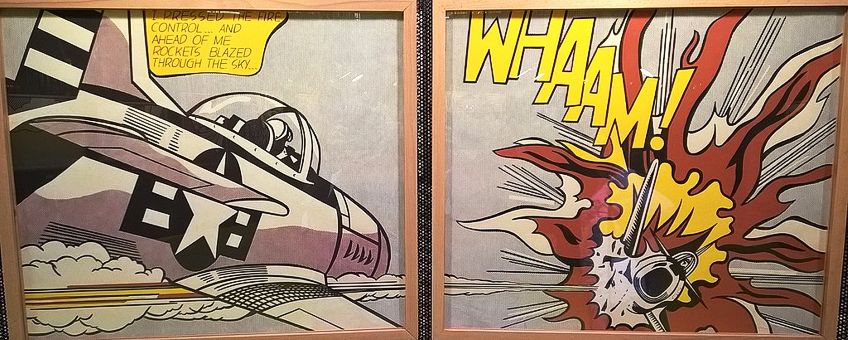
Although he uses popular imagery in his paintings, Lichtenstein’s works are not mere duplicates. Lichtenstein would focus on a single panel from a comic book, often cropping it down to alter the story. Lichtenstein would also add or remove various elements and play around with language and text. Lichtenstein further blurred the line between fine art and mass reproduction by hand painting the traditionally machine-printed dots.
The Monumental Image: James Rosenquist
Rosenquist was another artist who appropriated popular culture images directly in his paintings. However, like Lichtenstein, Rosenquist did not simply produce copies. Instead, Rosenquist juxtaposes various celebrities, products, and images in a Surrealist manner.
Many of Rosenquist’s works also include striking political messages. Rosenquist would begin his works by creating collages of advertisements and photo-spread clippings. He would then transform the simple collage into a cohesive painting.
Rosenquist began his artistic career painting billboards, and he was able to transition perfectly into rendering his collages on monumental scales. Many of Rosenquist’s works were 20 feet wide or bigger. By inflating mundane images from popular culture on such a large scale, Rosenquist was able to elevate the ordinary to the status of fine art.
Repetition: Andy Warhol and Repetition
When you think of Pop Art, Andy Warhol’s name will likely pop into your mind. Warhol is one of the most famous Pop artists, and his style is iconic and instantly recognizable globally. Warhol is perhaps most well-known for his brightly colored celebrity portraits. Warhol experimented with many varied subject matters throughout his illustrious career.
The common thread underlying all of his work is the inspiration of mass consumerism and popular culture. Repetition is another key element of Warhol’s work, commenting on the mass reproduction within the modern age.
Coca-Cola bottles and Campbell’s soup cans feature prominently in many of Warhol’s earliest works. Warhol would reproduce the images of these items ad infinitum, turning gallery walls into supermarket shelves. To further mimic and parody mass-production, Warhol began to screenprint his works, which had previously been hand-painted.
By insisting on creating his works mechanically, Warhol was rejecting the notion of artistic genius and authenticity. In its place, Warhol emphasized the commodification of art in the modern age, equating paintings with cans of soup. Both soup and paintings can be bought and sold as consumer goods, and both have inherent material worth. Warhol went even further, equating mass-produced consumer goods with celebrity figures like Marilyn Monroe.
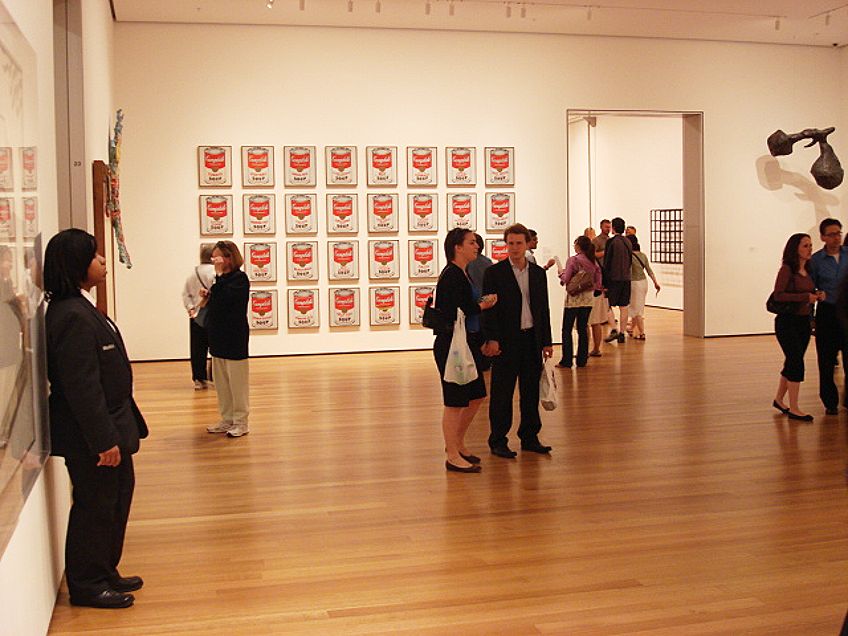
Pop Sculpture: Claes Oldenburg
Although sculpture seems like a perfect medium for Pop Art, Oldenburg was one of the very few Pop artists to explore it. Today Oldenburg is famed for his soft sculptures, and enormous public replicas of mundane consumerist objects, many of his earlier works were on a much smaller scale. In 1961, Oldenburg created an exhibition called The Store where he rented a storefront in New York that sold his small sculptural replicas of mundane objects.
Shortly after The Store, Oldenburg began to experiment with soft sculptures. Oldenburg would use fabric and stuffing to construct large ice cream cones, slices of cake, mixers, and other consumerist items. These soft sculptures would collapse in on themselves, perhaps commenting on the hollowness of consumerist items.
Throughout his career, Oldenburg focused entirely on commonplace objects. Following his soft sculptures, Oldenburg began to create grand pieces of public art. His 1974 Clothespin sculpture in Philadelphia was 45 feet high. A sense of playfulness towards presenting the mundane in unconventional ways permeates all Oldenburg’s works, regardless of the scale.
Pop Art in Los Angeles
While New York City was the birthplace of American Pop Art, Los Angeles had its own brand. The New York scene was far more rigid than Los Angeles, which did not have the established critics and galleries of East Coast America. This lack of rigidity translates into the Pop artists who worked and lived in Los Angeles.
In 1962, the Pasadena Art Museum held the first Pop Art survey. The New Painting of Common Objects exhibition showcased the works of Lichtenstein, Warhol, and Los Angeles artists Joe Goode, Ed Ruscha, Robert Dowd, and Phillip Hefferton.
There was another Pop Art aesthetic practiced by Los Angeles Pop artists like Billy Al Bengston. The works in this aesthetic referenced motorcycles and surfing, and used new materials like automobile paint. Making the familiar strange was a central theme in much of Los Angeles Pop art.
Using unexpected and new combinations of media and images, and shifting the focus away from consumer goods, Los Angeles Pop artists moved Pop Art beyond pure replication. These artists began to evoke particular attitudes, feelings, and ideas in their works, basing their compositions on experiences and pushing the boundaries between popular culture and fine art.
Signage: Ed Ruscha
Ruscha was one of the leading Los Angeles Pop artists, and he used a variety of media in his works. Most of his works were either painted or printed, and he often used phrases or words as the subjects of his early works, highlighting the omnipresence of Los Angeles signage. Ruscha’s works blur the lines between abstraction, painting, and advertising signage, which undermined the divisions between commerce and aesthetics.
Most of Ruscha’s work is highly conceptual, and he tended to focus on the idea behind the work rather than the image itself. As with many Pop artists, Ruscha’s work went beyond simply reproducing consumerist images and objects. Instead, he examined the interchangeability of experience, text, image, and place.
French Nouveau Réalisme
In 1960, art critic Pierre Restany founded the Nouveau Réalisme movement by drafting the “Constitutive Declaration of New Realism.” This document claimed that Nouveau Réalisme was a new way of perceiving reality. Nine artists, united in their appropriation of mass culture, signed the declaration in the workshop of Yves Klein. The principle of poetically recycling the reality of the industry, urban life, and advertisement is evident in the decollage techniques of Villegle. New images were created by cutting through layers of posters.
The American Pop Art concerns with commercial culture were echoed in the Nouveau Réalisme movement. However, these artists were more concerned with objects rather than paintings.
German Capitalist Realism
The German counterpart to American and British Pop Art was the Capitalist Realism movement. In 1963, Sigmar Polke founded the movement, which used a mass-media aesthetic to explore objects from commodity culture.
Other artists like Konrad Leug and Gerhard Richter sought to expose the superficiality and consumerism of modern Capitalist societies by using aesthetics and imagery in their own work. Richter scrutinized culture through photography, Polke explored the creative capacity of mechanical production, and Leug explored the imagery of Pop culture.
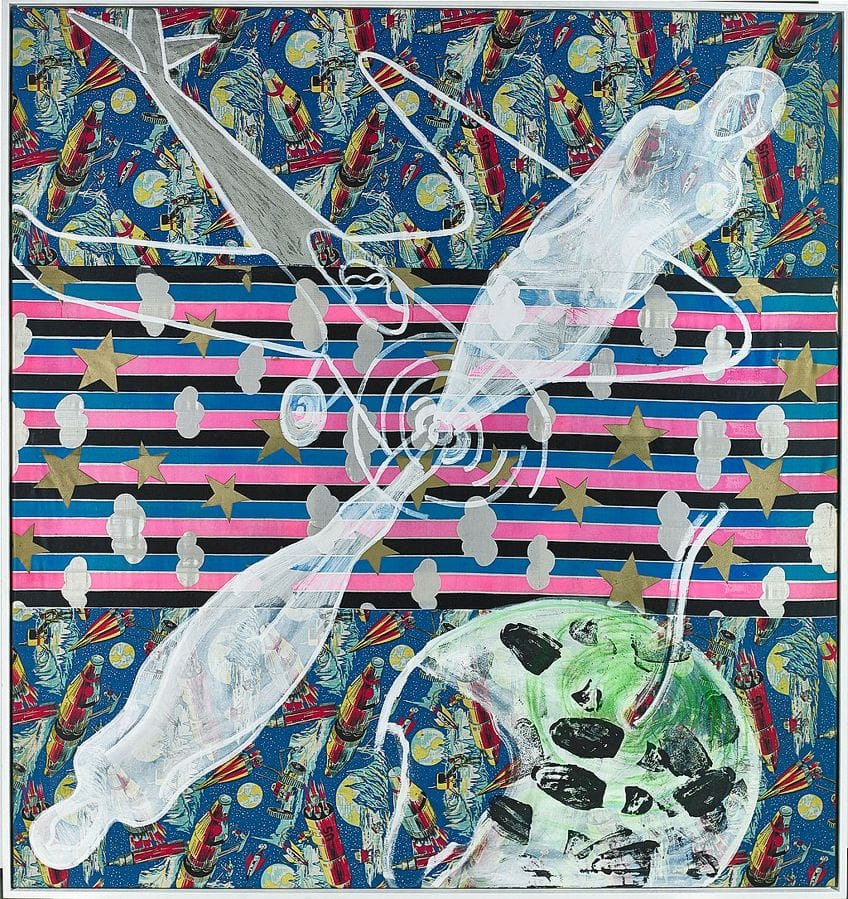
Famous Pop Art Pieces
As with any movement, there is a great amount of diversity within Pop Art. The movement lays claim to many varied artists, each of whom made valuable contributions to developing modernism. In this section of the article, we explore some of the most famous Pop Art pieces and investigate their contribution to one of the most well-known art movements of the 21st century.
Eduardo Paolozzi: I was a Rich Man’s Plaything (1947)
Eduardo Paolozzi was a Scottish-born artist and sculptor who was a crucial member of the post-war Avant-Garde in England. In 1947 he completed this collage of popular images, a piece which hints at the Pop Art movement that would follow only a few years later. Paolozzi uses a Coca-Cola advert, the cover of a pulp fiction novel, and a recruitment advertisement for the military in this collage.
Like a lot of British Pop Art, this piece reflects a darker, more critical tone. The work is a perfect example of how British Pop Art reflected on the gap between the harsh political and economic reality of post-war Britain and the affluent glamour idealized in popular American culture. Paolozzi became a member of the Independent Group, and much of his work investigates the impact of mass culture and technology on fine or high art.
Paolozzi’s choice of the collage medium nods to the photomontage influences of the Dadaist and Surrealist movements . By physically collating a wide range of popular culture images and Pop Art ideas on a single page, Paolozzi recreates the everyday barrage of mass-media images in the modern world.
Richard Hamilton: Just What Is It That Makes Today’s Homes So Different, So Appealing? (1956)
Collage was a popular form of early Pop Art, and this collage by Richard Hamilton is another rich example. Hamilton made this piece for the 1956 This is Tomorrow exhibition. This collage was the advertisement for the exhibit, and it was featured in the catalog. Many critics cite this collage as the very first work of the British Pop Art movement.
In the collage, we can see a modern-day Adam and Eve. Rather than biblical figures, these two are a burlesque dancer and a bodybuilder. These two foundational characters sit within a milieu of modern-day conveniences, including canned ham, a vacuum cleaner, and a television.
Hamilton cut each element from advertisements in magazines. The scene that Hamilton creates both upholds and exploits consumerism. Hamilton also offers a stinging critique of the decadence of the American post-war years.
James Rosenquist: President-Elect (1960-61)
This painting is the first piece on our list that is not a collage, but it did start its life as one. Rosenquist began creating this piece by making a collage with three distinct elements. Each element is cut from various mass-media items. The face of John F. Kennedy, a yellow Chevrolet, and a piece of cake adorn the painting. Rosenquist then transformed the amalgamation of consumerist objects into a monumental, photo-realistic painting.
Rosenquist stated that he had chosen to use the face of John F. Kennedy from one of his campaign posters alongside other elements taken from advertisements because he was interested in the sudden trend of people advertising themselves like consumer goods.
Rosenquist skilfully blends the juxtaposing elements of a collage in painting, proving his artistic talent and ability to offer striking cultural and political commentary through popular imagery.
Claes Oldenburg: Pastry Case, I (1961-62)
Although the sculpture was not the most common medium in the Pop Art movement, Oldenburg was the most notorious Pop sculptor. If you have ever seen any large, playfully absurd sculptures of inanimate objects or food, they were likely created by Oldenburg.
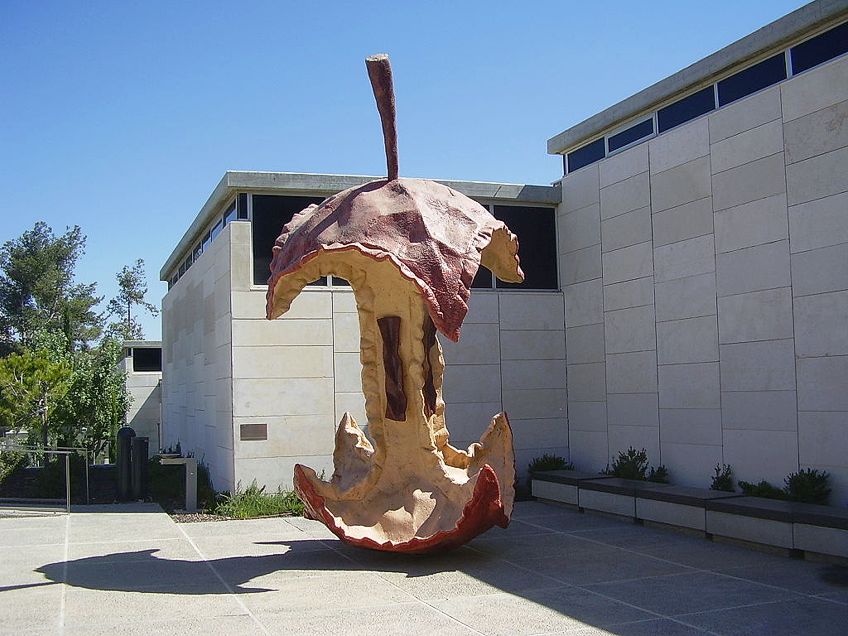
Pastry Case, I is a collection of works that Oldenburg exhibited at his 1961 The Store installation. The Store was a shop on the Lower East Side in New York, where Oldenburg created and displayed sculptural objects. Oldenburg’s plaster candied apples, strawberry shortcakes, and other consumer items were displayed in his shop-like installation.
Not only were Oldenburg’s pieces commercial products, but he also sold them from The Store at very low prices. The installation and the Pastry Case I collection comment on the relationship between commercial goods and art as commodities. Although Oldenburg sold these pieces as if they were mass-produced consumer goods, they were all delicately hand-made.
Oldenburg includes yet another cultural critique in these pieces through the lavishly expressive brushstrokes he uses to paint each object. Many believe that these brushstrokes mock the work of Abstract Expressionists. Criticism of Abstract Expressionism is a common thread throughout much Pop Art. Oldenburg creates a highly ironic environment as he combines highly commercial items with Expressionist brushstrokes.

Roy Lichtenstein: Drowning Girl (1963)
Towards the beginning of the 1960s, Lichtenstein was growing in fame. Lichtenstein specialized in paintings that drew on popular comics, and this is one of his most well-known pieces. Before Lichtenstein, no Pop artist had ever focused exclusively on cartoon imagery. Other artists like Jasper Johns and Robert Rauschenberg had both used popular imagery in their works previously, but Lichtenstein was the first to focus on cartoons.
It was the work of Lichtenstein and Andy Warhol which hailed the beginning of the Pop Art movement. While Lichtenstein worked exclusively with comics, he did not copy them directly from their sources. Instead, he used intricate techniques, cropping comic images to create novel and exciting compositions. Lichtenstein would also alter the writing in each of his paintings, condensing it and pointing to the visual significance of writing in the comic genre.
Drowning Girl is a good example of this technique because the original source image included the girl’s boyfriend standing above her on a boat. In his paintings, Lichtenstein re-appropriates these aspects of commercial art. In doing so, he challenges existing views about the hierarchy of art forms.
As with many Pop art paintings, it is unclear whether Lichtenstein endorses or critiques the comic form in his paintings. Does he approve of the comic style and mimic it to increase its value, or is it a scathing critique? The answer to this question is left up to the interpretation of the viewer.
Sigmar Polke: Bunnies (1966)
Sigmar Polke was a significant figure in German Capitalist Realism, having co-founded the movement in 1963. Alongside other artists like Konrad Leug and Gerhard Richter , Polke began painting images of popular culture. These paintings elicit a cool cynicism about the state of the German economy following the Second World War. These Pop Art paintings also invoke a sense of genuine nostalgia for the images themselves.
As Lichtenstein began replicating Ben-Day dots, Polke began mimicking commercial four-color printing dot patterns. In his painting Bunnies, Polke recreates a Playboy Club image of four of their costumed bunnies. The disruption of the dot printing technique on the canvas interrupts the mass-marketing effects of sexual appeal. The closer the viewer gets to see the scantily clad women, the less they can see.
In most of his paintings, Polke does not invite the personal identification of the viewer. Instead, Polke’s paintings become allegories for losing the self in the torrent of commercial imagery. The dissonance between the heightened sexuality of the Playboy bunnies and the dot patterns echoes the conflict between a yearning for mass-commercial modern life and being simultaneously repelled by the very idea.
In comparison to New York Pop artists, Polke’s work is much more openly critical of the consumerism within popular culture. These views are rooted in the Capitalist Realism movement. Rather than offering shielded and slightly covert critiques of popular culture, Polke tackles it head-on.

Ed Ruscha: Standard Station (1966)
On the West Coast of America, Ed Ruscha was one of the most prominent Pop photographers, printmakers, and painters. Much of Ruscha’s work is a unique and colorful blend of Hollywood imagery, the Southwestern landscape, and commercial culture. The gas station, like the one in Standard Station, is a common motif throughout his work. In fact, in his book called Twentysix Gasoline Stations (1963), Ruscha documents a road trip he took through the Southwestern countryside.
In this painting, Ruscha is able to mold the ordinary and prosaic image of a gas station into an emblem of consumerist American culture. Ruscha screen prints this image, which flattens the perspective and reflects the commercial advertisement aesthetic. It is also possible to see Ruscha’s early experiments with interplaying text and language. In his later works, Ruscha would build on these early experiments and language would become an integral part of his conceptual works.
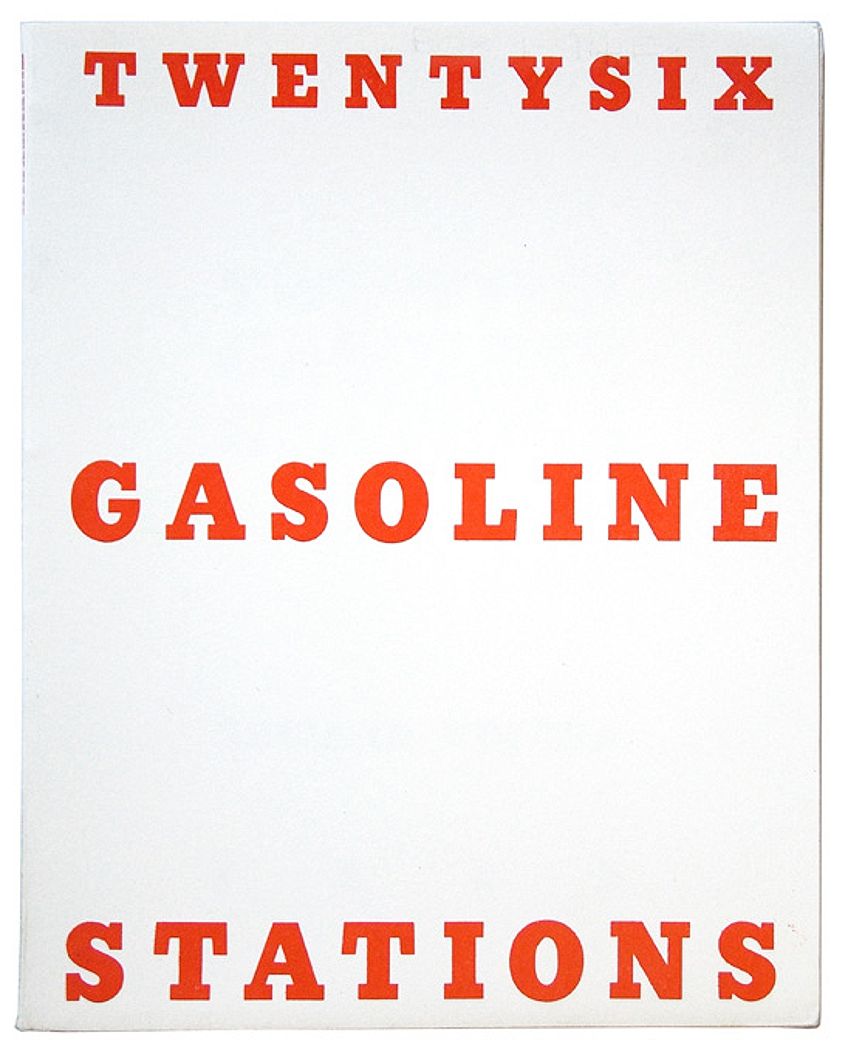
David Hockney: A Bigger Splash (1967)
Hockney created this considerable canvas of 94 squared inches from a reference photo in a pool magazine. For Hockney, the idea that it was possible to capture a fleeting event from a photograph in a painting was intriguing. While the moment of the splash was brief, the process of painting was much longer. Hockney manages to contrast the static rigidity of the geometric house, palm trees, pool edge, bright yellow diving board with the dynamism of the water splash. The result is an intentionally disjointed feeling.
The artificial stylization of this painting is typical of the Pop Art style.
Andy Warhol: Campbell’s Soup I (1968)
This painting is one of a whole series on Campbell’s Soup Cans by Andy Warhol. Unlike the works of Abstract Expressionists, Warhol never intended for people to celebrate these paintings for their compositional style or form.
Warhol is one of the most famous Pop artists, and he is best known for using universally recognizable popular imagery in a fine art context. In addition to his series on Campbell’s Soup Cans, Warhol also used the face of Marilyn Monroe , Mickey Mouse, and other famous figures.

By presenting these various popular images in a repetitive style, Warhol created a sense of mass-production in the context of fine or high art. For Warhol, it was not a case of emphasizing or celebrating popular imagery, but rather to provide a social commentary about consumerism. In modern times, commodities like celebrities, soup, and cartoons, become identifiable with a single glance.
Although Warhol painted this early series, he quickly turned to screenprinting. Not only was screenprinting far more economical, but he could infuse his mass-produced commodities with an even greater sense of mass-production. In Warhol’s first solo exhibition in Los Angeles, he presented 100 canvases of Campbell’s Soup Cans. This exhibit at the Ferus Gallery immediately placed Warhol on the world map and flung him to greater heights.
Pop Art is certainly one of the most well-known art movements of the 21st century. In the wake of global war and hardship, the movement was a thoroughly modern examination of the growing consumerism and excess of the modern world. Behind the bright colors, playful compositions, and absurd aesthetic lies a cutting cultural critique.

Isabella studied at the University of Cape Town in South Africa and graduated with a Bachelor of Arts majoring in English Literature & Language and Psychology. Throughout her undergraduate years, she took Art History as an additional subject and absolutely loved it. Building on from her art history knowledge that began in high school, art has always been a particular area of fascination for her. From learning about artworks previously unknown to her, or sharpening her existing understanding of specific works, the ability to continue learning within this interesting sphere excites her greatly.
Her focal points of interest in art history encompass profiling specific artists and art movements, as it is these areas where she is able to really dig deep into the rich narrative of the art world. Additionally, she particularly enjoys exploring the different artistic styles of the 20 th century, as well as the important impact that female artists have had on the development of art history.
Learn more about Isabella Meyer and the Art in Context Team .
Cite this Article
Isabella, Meyer, “Pop Art – The Fusion of High Art and Popular Culture.” Art in Context. April 19, 2021. URL: https://artincontext.org/pop-art/
Meyer, I. (2021, 19 April). Pop Art – The Fusion of High Art and Popular Culture. Art in Context. https://artincontext.org/pop-art/
Meyer, Isabella. “Pop Art – The Fusion of High Art and Popular Culture.” Art in Context , April 19, 2021. https://artincontext.org/pop-art/ .
Similar Posts

Political Art – How We Use Art As a Political Statement
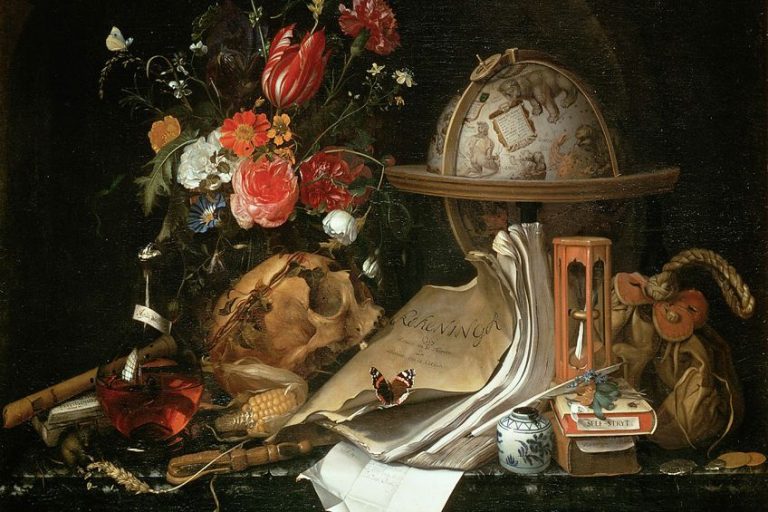
Memento Mori Art – Symbolic Meditations on Death

Dystopian Surrealism – The Other-Worldly Horrors of Dystopian Art

Ikebana Art – Learn About the Japanese Art of Flower Arrangement

Medici Family – Who Were the Medicis, the Famous Art Family?

Installation Art – Exploring the Multisensory Art World
Leave a reply cancel reply.
Your email address will not be published. Required fields are marked *
Save my name, email, and website in this browser for the next time I comment.
The Most Famous Artists and Artworks
Discover the most famous artists, paintings, sculptors…in all of history!

MOST FAMOUS ARTISTS AND ARTWORKS
Discover the most famous artists, paintings, sculptors!


Andy Warhol, Gold Marilyn Monroe , 1962, silkscreen on canvas, 211.4 x 144.7 cm ( Museum of Modern Art, New York )
Popular culture, “popular” art
At first glance, Pop art might seem to glorify popular culture by elevating soup cans, comic strips and hamburgers to the status of fine art on the walls of museums. But, then again, a second look may suggest a critique of the mass marketing practices and consumer culture that emerged in the United States after World War II. Andy Warhol’s Gold Marilyn Monroe clearly reflects this inherent irony of Pop. The central image on a gold background evokes a religious tradition of painted icons, transforming the Hollywood starlet into a Byzantine Madonna that reflects our obsession with celebrity. Notably, Warhol’s spiritual reference was especially poignant given Monroe’s suicide a few months earlier. Like religious fanatics, the actress’s fans worshipped their idol; yet, Warhol’s sloppy silkscreening calls attention to the artifice of Marilyn’s glamorous façade and places her alongside other mass-marketed commodities like a can of soup or a box of Brillo pads.
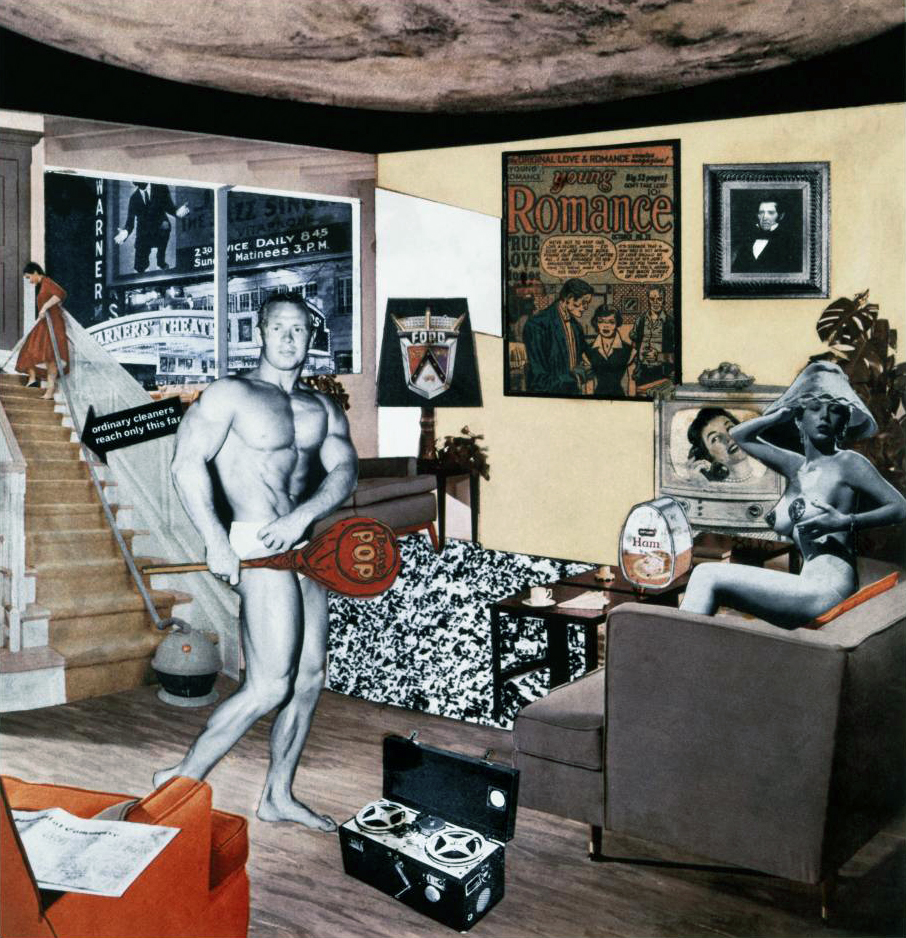
Richard Hamilton, Just what is it that makes today’s homes so different, so appealing? , 1956, collage, 26 cm × 24.8 cm (Kunsthalle Tübingen, Tübingen)
Genesis of Pop
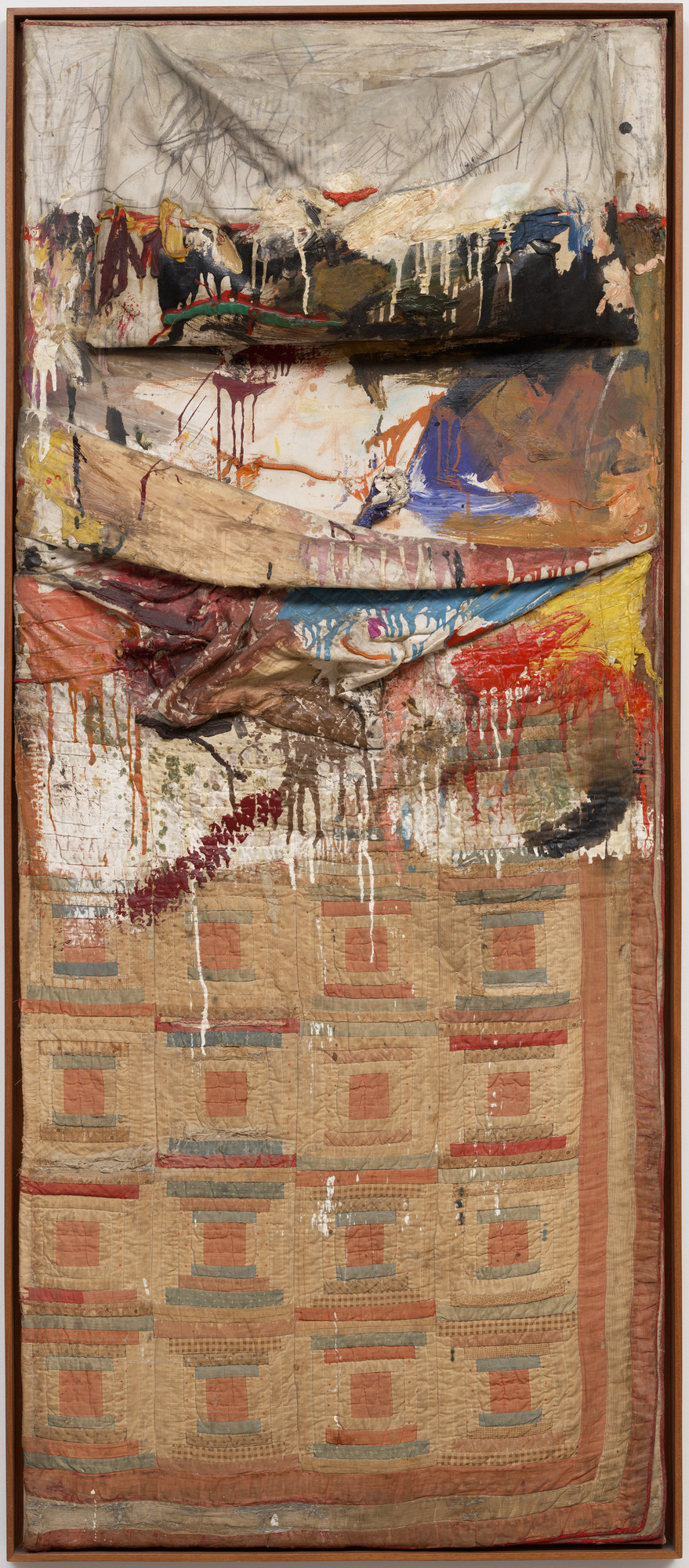
Robert Rauschenberg, Bed , 1955, oil and pencil on pillow, quilt, and sheet on wood supports, 191.1 x 80 x 20.3 cm ( The Museum of Modern Art, New York )
In this light, it’s not surprising that the term “Pop art” first emerged in Great Britain, which suffered great economic hardship after the war. In the late 1940s, artists of the “Independent Group,” first began to appropriate idealized images of the American lifestyle they found in popular magazines as part of their critique of British society. Critic Lawrence Alloway and artist Richard Hamilton are usually credited with coining the term, possibly in the context of Hamilton’s famous collage Just what is it that makes today’s home so different, so appealing? Made to announce the Independent Group’s 1956 exhibition “This Is Tomorrow,” in London, the image prominently features a muscular semi-nude man, holding a phallically positioned Tootsie Pop.
Pop art’s origins, however, can be traced back even further. In 1917, Marcel Duchamp asserted that any object—including his notorious example of a urinal —could be art, as long as the artist intended it as such. Artists of the 1950s built on this notion to challenge boundaries distinguishing art from real life, in disciplines of music and dance, as well as visual art. Robert Rauschenberg’s desire to “work in the gap between art and life,” for example, led him to incorporate such objects as bed pillows , tires, and even a stuffed goat in his “ combine paintings ” that merged features of painting and sculpture. Likewise, Claes Oldenberg created The Store , an installation in a vacant storefront where he sold crudely fashioned sculptures of brand-name consumer goods. These “Proto-pop” artists were, in part, reacting against the rigid critical structure and lofty philosophies surrounding Abstract Expressionism , the dominant art movement of the time; but their work also reflected the numerous social changes taking place around them.
Post-war consumer culture grabs hold (and never lets go)
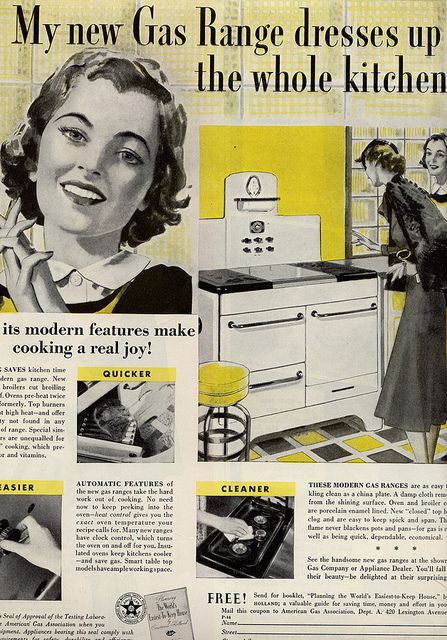
c. 1950s advertisement for the American Gas Association
The years following World War II saw enormous growth in the American economy, which, combined with innovations in technology and the media, spawned a consumer culture with more leisure time and expendable income than ever before. The manufacturing industry that had expanded during the war now began to mass-produce everything from hairspray and washing machines to shiny new convertibles, which advertisers claimed all would bring ultimate joy to their owners. Significantly, the development of television, as well as changes in print advertising, placed new emphasis on graphic images and recognizable brand logos—something that we now take for granted in our visually saturated world.
It was in this artistic and cultural context that Pop artists developed their distinctive style of the early 1960s. Characterized by clearly rendered images of popular subject matter, it seemed to assault the standards of modern painting, which had embraced abstraction as a reflection of universal truths and individual expression.
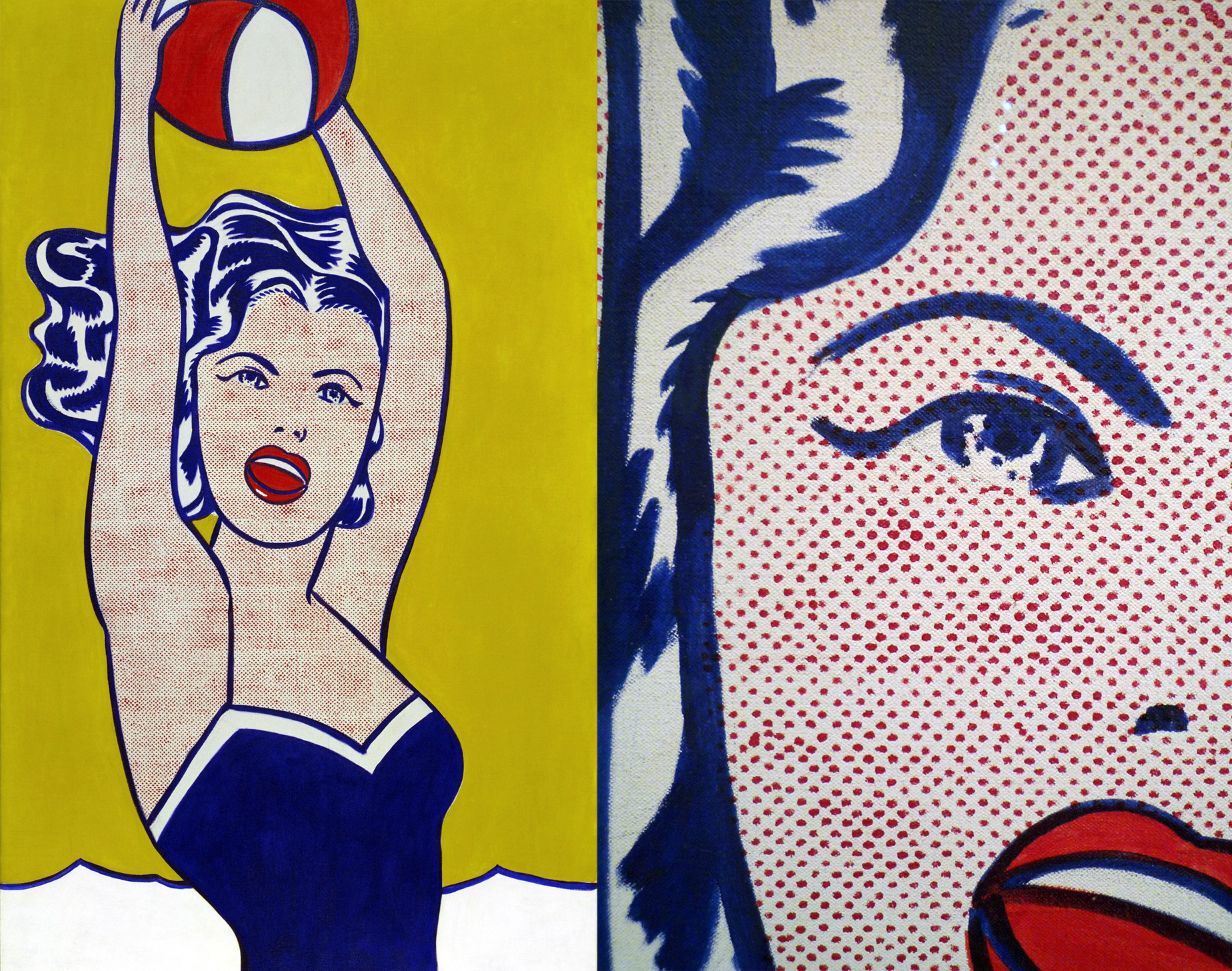
Left: Roy Lichtenstein, Girl with a Ball , 1961, oil on canvas, 153 x 91.9 cm ( Museum of Modern Art, New York ); right: Detail of face showing Lichtenstein’s painted Ben-Day dots, Roy Lichtenstein, Girl with a Ball , 1961, oil on canvas, 153 x 91.9 cm ( Museum of Modern Art, New York, photo: Steven Zucker , CC BY-NC-SA 2.0)
Irony and iron-ons
In contrast to the dripping paint and slashing brushstrokes of Abstract Expressionism—and even of Proto-Pop art—Pop artists applied their paint to imitate the look of industrial printing techniques. This ironic approach is exemplified by Lichtenstein’s methodically painted Ben-Day dots, a mechanical process used to print pulp comics.
As the decade progressed, artists shifted away from painting towards the use of industrial techniques. Warhol began making silkscreens, before removing himself further from the process by having others do the actual printing in his studio, aptly named “The Factory.” Similarly, Oldenburg abandoned his early installations and performances, to produce the large-scale sculptures of cake slices , lipsticks , and clothespins that he is best known for today.
Additional resources
Read a chapter in our textbook, Reframing Art History —” Popular, Transient, Expendable: Print Culture and Propaganda in the 20th century .”
Pop art on the Metropolitan Museum of Art’s Heilbrunn Timeline of Art History.

Smarthistory images for teaching and learning:
[flickr_tags user_id=”82032880@N00″ tags=”PopIntro,”]
More Smarthistory images…
Cite this page
Your donations help make art history free and accessible to everyone!
> Texte français
This dossier forms part of the series A Movement, a Period . These dossiers are shaped around a selection of works from the main movements and tendencies represented in the collections of the National Museum of Modern Art. Each of these dossiers includes: - a general introduction which will present and situate the role of the movement in a historical, geographical and aesthetic context, - a selection of the most representative works from the Museum's collections, contained in individual files each with notes, a reproduction and a biography of each artist, - a chronology. FOR YOUR INFORMATION There are more than 59,000 works in the Museum's collections. The Museum regularly varies the works on show in the exhibition spaces on the 4 th and 5 th levels of the Pompidou Centre. The educational dossiers have links set up to these new hangs. To know more about the museum collections: www.centrepompidou.fr/muse e
While the term Pop Art is widely known nowadays, its artistic scope and the issues it raises are nonetheless frequently misunderstood.
Pop Art in Britain refers to a group of artists who began appearing on the scene in the mid-1950s. This identity was formed around The Independent Group , an intellectual circle consisting of the painters Eduardo Paolozzi and Richard Hamilton , the architectural partnership of Alison and Peter Smithson , and the art critic Lawrence Alloway . In its theoretical explorations, The Independent Group focused on a theoretical exploration of technology, hence the recurring references to science-fiction in British Pop Art .
American Pop Art had no explicit linkups with British Pop Art and refers to a tendency that arose from individual initiatives. Though it was not a structured movement in the sense of a group putting on collective shows, it does however have a certain coherence. In general terms, it emerged from the work of Robert Rauschenberg and, chiefly, Jasper Johns , and is characterised by an interest in ordinary objects, irony, and a faith in the potency of images. American Pop Art has its home specifically in New York, where at the outset artists such as Claes Oldenburg and Jim Dine , Roy Lichtenstein and Andy Warhol exhibited, then James Rosenquist , George Segal and Tom Wesselman .
Aside from their genealogical divergences, British Pop Art and American Pop Art occupy common ground in their assumption of the same term. The term Pop Art was coined by Lawrence Alloway in the late 1950s, to indicate that art has a basis in the popular culture of its day and takes from it a faith in the power of images. But while Pop Art quotes from a culture specific to the consumer society, it does so in ironic mode, as inferred from the British painter Richard Hamilton's definition of his artistic output: "Popular, transient, expendable, low-cost, mass-produced, young, witty, sexy, gimmicky, glamorous, and Big Business".
However, this reference to popular culture is not cut and dried. How far can Pop Art go in quoting it without being confused with it? While each individual artist brings his or her own singular response, it seems that Pop Art and "Pop Culture" are not to be confused, and that they maintain a dialectical relationship. While Pop Art takes its materials from mass culture, mass culture in return profits from the former's stylistic innovations.
From the early 60s up until 1970, the Pop tendency was multidisciplinary and international in character, something which was largely apparent in Italian design (for example, Piero Gatti 's famous Sacco armchair, 1968, which recalled Claes Oldenburg's soft objects) and the Utopian architecture of the Archigram group (like Ron Herron 's idea for Walking City , 1964) derived from the futuristic world of comic strips.
After 1970, the artists were to turn to much more oppositional preoccupations.
Jasper Johns Augusta, Georgia 1930

This is the only painting by Jasper Johns in a French public collection. A large number 5, buried in paint, it appears as an emblematic figure of the art of the time. Almost as an act of synthesis, it represents the transition from an art of abstract expressionism, such as was developed in the US after the war, towards the figure, which will instead dominate the next decade.
But here, as is often the case with Johns, the subject is ambiguous , for in the first instance this is only an abstract representation and, though it seems universally readable, it has no symbolic referent. Of course, one thinks of the use of the same number 5 by Charles Demuth in a painting famous in the US: I saw the figure 5 in gold , 1928 (New York, the Metropolitan Museum). However, in Johns the use of numbers, periodically returned to from 1955 on, is not idealised as in Demuth. The figure 5 is here the object of the painting , in broad black and white brush strokes which in places allow the newspaper pasted to the canvas to show through.
Figure 5 comes from the Scull Collection , which is particularly rich in post-war American works of art. The Museum also holds a series of ten original collages on lithographs which returned to the theme of figures: Figure 0 to 9 , 1960-1971.
Biography Jasper Johns studied at the University of South Carolina until 1948. He then moved to New York where he learned commercial drawing before beginning military service in the US Army. Back from this in 1952, he made stained-glass and worked in a bookshop. He formed a friendship with Robert Rauschenberg in 1954. His early paintings, done with wax, a thick and translucent material, showing flags, targets and numbers, were first shown to the public in his first solo exhibition, at the Leo Castelli Gallery in New York in 1958. The choice of these two-dimensional familiar objects, together with the disassociation in operation between painting and personal expression heralded the advent of Pop Art and the simultaneous progressive eclipsing of Abstract Expressionism . However, Johns strove to keep his distance from the movement in order to preserve the singularity of his own work. By using imagery that came out of commonplaces, what he described as things already known as ideas, he was asking questions about the real function of painting. The representation of the same theme allowed him to practise different techniques for drawing attention to the object. After meeting Marcel Duchamp through the composer John Cage and the choreographer Merce Cunningham , with whom he collaborated, in 1960 he began a series of sculptures in painted bronze representing ordinary objects such as electric light bulbs or beer cans; the purpose was to highlight the freshness of their banality in the human world. Simultaneously, he produced drawings and lithographs which make him one of the contemporary masters in the field of graphic art.
Roy Lichtenstein New York, 1923-1997

Modular Painting , 1969, is composed of four panels which are identical both in their dimensions and in the discernible subject matter. Yet the manner of their construction produces a central geometrical form which gives the impression that these panels have heterogeneous forms.
Lichtenstein is an illusionist . Modular Painting , with its impersonal and mechanical execution, keeps the viewer's gaze at a distance all the better to draw it in. This seemingly simple and austere composition can be interpreted as an ironic reference to abstract painting.
All the same, this is not exactly an abstract picture. Abstract art refers to itself and is never the image of anything. But Lichtenstein's picture is a reproduction, as we can see from the screen dots, the kind of screenprinting also to be found in reproduced photographs and some comic strips. Modular painting , a painted reproduction of modular forms printed in a newspaper, is the copy of a copy. We can see that it is an enlargement of what it reproduces since the screen is extremely visible. But nothing allows us to think that the modular forms reproduced by Lichtenstein are true copies of an original. The original may not have existed; nor, therefore, its reproduction.
This picture, first taking to be a geometric abstract painting, which by definition reproduces nothing, is perhaps only simulating its representative function .
Biography Roy Lichtenstein is one of the major figures of American Pop Art . In 1961, at the dawn of the movement, he had the idea of painting an enlargement of a comic strip image taken from a magazine. This was the starting point for a whole series produced on the basis of comic strips and advertising images which he continued until 1964. Lichtenstein was fascinated by the efficacy of these popular representations in which objects and passions are reduced to an accessible and anonymous essential that strikes him as having a vitality greatly superior to Abstract Expressionism , which at the time had sunk into academicism. With the aim of achieving a high degree of neutrality, he painted the effects produced by printing techniques and the constraints of advertising imagery: the hatchings, the standard flat colours and the screen dots for shadow and relief. In 1964, he began a new serie of motifs with this vocabulary: tourist landscapes, paintings based on icons of the history of modern art, hyperrealist mirrors and paintings which quote from his earlier works. The style which spectacularly characterises his work, beginning with the first Look Mickey in 1961, puts a perceptible distance between the model and the viewer. This way of dealing with images can be an ironic, acerbic or speculative style of critique, as in the Modular Paintings of 1969-1970, of which this example is held by the Museum. The Lichtenstein foundation website
Claes Oldenburg Stockholm, 1929

With his "Ghost" Drum Set made of canvas stitched and painted white, Oldenburg is taking an object typical of pop-rock culture and subjecting it to the transformation that is both witty and grotesque. The drum kit becomes absurd as something made out of soft material, since it loses one of its essential attributes, the rigidity of the percussive cylinders. But the object becomes even more fragile and, because of its whiteness, apt to be blanked out and disappear, evoking the childhood idea of a ghost.
The ghost version has its basis in a soft version that Oldenburg made in 1967 for an exhibition at the Guggenheim Museum in New York. This was a piece made in colour, and in parallel to a monumental project imagined in 1966 for a big top in a London leisure park, in which the drums would enclose auditoriums. Miniature portable versions were also produced in 1970.
Through this series of works, Oldenburg is moving through a cycle which he set out to impose upon the objects on which he works. After an initial phase of energy and activity represented by a hard version, the object deteriorates by becoming soft, and undergoes entropy to the point when it dies, completing its cycle in a ghost version, a phase of decomposition whereby its matter is obliterated and only the idea remains. "Ghost" Drum Set is this final phase.
Biography After studying art and literature at the prestigious Yale University, Oldenburg took evening classes at the Art Institute of Chicago, from 1950 to 1952. He moved to New York in 1956. There he met Allan Kaprow , the inventor of the Happening, who invited him to take part in these events. This is how Oldenburg began organising his own Happenings. Influenced by art brut, his first plastic works use various junk materials. In the early 60s he made his first coloured plaster objects which he put up for sale at his studio, The Store . As indicated by its name, this was a place with all the appearances of a shop and having a shop window; the artist's project was to muddle the codes which distinguish the art market from ordinary commerce. His soft sculptures were shown to the public for the first time at the Green Gallery in New York in 1962. These are works which disrupt the scale and the substance of everyday objects, objects from the food industry - ice creams, hamburgers and fries - or accessories which incidentally furnish the modern home - plugs, telephones, wash basins. Subsequently, he extended these explorations by showing his objects in three versions: a hard version in painted wood, a soft version in cloth or vinyl, and a ghost version which is a colourless reproduction of the object, each of these states corresponding to the development of the material towards final entropy. As a complement to this work on the transformation of the object, Oldenburg was engaged in projects for public monuments, which he developed in the 70s, working with his companion, the Dutch art historian Coosje van Bruggen . Using sketched designs, he put forward suggestions to people the urban landscape with ordinary objects enlarged to such a point that they provoke a grotesque visual effect, like the lipstick installed at Yale University 1969 or the half-buried bicycle recently done in Paris at the La Villette Park. A website on Oldenburg
Robert Rauschenberg Port Arthur, Texas, 1925

Made in collaboration with the engineers Billy Klüver and Harold Hodges , Oracle is a five-piece interactive sculpture formed from an assemblage of salvage objects (car door, ventilation ducts, window...) belonging to the world of "everyday technology", with which is integrated a sophisticated system of radios capturing the various sounds emitted in the location where the work is shown. The radio sets were from the start connected to a console meant to be manipulated by visitors. Each of the five pieces, whose placing can vary depending upon the exhibition space, has a specific structure and mode of working.
Although akin to some of Tinguely 's machines, this installation of machines living a life of their own and interrogating the relationship between Junk Culture * and technology is more tragic than playful in Rauschenberg's case. Shown at the Leo Castelli Gallery in New York in 1965, this work also featured in an exhibition organised by the Museum of Modern Art in New York in 1968: The Machine as seen at the end of the Machine Age .
* Junk Art is an expression attributed by Lawrence Alloway, in the 1950s, to works, chiefly sculptures, made from salvage objects.
Biography After studying pharmacy, and service in the American navy during the Second World War, Robert Rauschenberg began his art training at the Kansas City art Institute. In 1948 he visited Paris and enrolled as a student at the Académie Jullian. Back in the United States the following year, he entered the Black Mountain College , where he met, among others, the composer John Cage , with whom he was to collaborate regularly from 1951, and the choreographer Merce Cunningham . In the mid 1950s, after a long trip to Europe, he made his first paintings integrating found objects, the Combine Paintings . A legacy of Schwitters , Cubist collages and Surrealist associations , these works bring together painted elements in the subjective style of the abstract expressionists and neutral elements introduced from the mass media. It was because of this work that he won acclaim, and with him American art, by achieving first prize at the 1964 Venice Biennale. In 1966, together with the electronic engineer Billy Klüver , he created Experiments in Art and Technology , an organisation whose purpose was to give guidance to artists exploring new technologies... In parallel, he collaborated on the artistic projects of his friends John Cage and Merce Cunningham, regularly producing sets and costumes for their performances.
James Rosenquist Grand Forks, North Dakota, 1933

Rosenquist very quickly found his identity as an artist: huge formats, a style of painting with broad, supple brushstrokes, vivid colours, though almost always brightened with white, giving an effect of depth and ambiguity, an effect he also aims for in his brusque disrupting of scale, something learned from his past occupation as an industrial painter.
President Elect is one of his few works that are directly inspired by advertising posters . Kennedy was at the time an image of optimism for the United States, like the cake and the car, tangible signs of this new era of prosperity. However, Rosenquist's originality was already apparent: a tripartate division of the surface, breaking the monotony of the image and allowing points of view and meanings to multiply, the undulating of light over the face of the President, grisaille for the hands which are grafted on like ghostly apparitions, in which some have seen the influence of Surrealism , denied by the artist himself.
Biography While earning his living as an industrial painter, in 1953 Rosenquist began taking classes in traditional painting techniques at the University of Minnesota. He then spent 1955 at the Art Students League in New York, where he was disappointed by the teaching. During this period, to support himself he painted gigantic advertising images at Times Square, an apprenticeship which would be more useful to him than any of his academic training. When he became friends with Rauschenberg and Johns , and with Ellsworth Kelly , he became definitively aware of his vocation as a painter. He began by making abstract pictures, but was dissatisfied with contemporary expressionist or minimalist tendencies, though he did keep certain stylistic characteristics of these, like the large format and the colours broken up with white, but he was drawn to figurative motifs typical of American society. In 1962, with his first solo exhibition at the Green Gallery in New York, his subjects and technique alike provoked violent controversy, but all his paintings sold. From then on, although he always defended himself from any interpretation of his work that was too unilaterally pop, he participated in all the Pop Art events. • The website of James Rosenquist
Andy Warhol Pittsburg, Pennsylvania, 1928 - New York, 1987

In 1963, when Warhol made this work, Elizabeth Taylor was at the centre of media attention. Her part in Joseph Mankiewicz 's Cleopatra was hotly criticised, on the grounds that she was "too fat" and "overpaid", in the words of one critic coming out of what was then the most costly film in the history of cinema. Nonetheless, it was not a contemporary photograph that Warhol used in this work, but the shot probably commissioned by the Columbia Pictures studios to promote another film, Suddenly Last Summer , also directed by Joseph Mankiewicz, in 1959.
This photograph belonged to Warhol, along with some fifty other portraits of Liz Taylor. By making this image public, the artist was inviting a comparison with the actress's features before and after the viral pneumonia that had threatened to carry her off in 1961. The glamour portrait from 1959 proves that the photographic record had for once and all immortalised her at the height of her beauty; it was this that Warhol was reminding the public of in this work.
Here he uses the silkscreen process , which consists in the mechanical repetition of an image on fabric while reducing it to its essential outlines; stripped of its details, the form acquires a greater visual impact . Moreover this potential, this technique deriving from the advertising industry for which Warhol had worked, allows him to approach his ideal of objectivity, whereby perfection would be a matter of identical reproduction. This operation's effect would be to separate the image from the meanings attributed to it, preserving only its appearance, the pure image . However, the multiplication of the portraits of "Liz" do not meet with the exactness of reproduction: no image is identical to any other.
With this work, Warhol is moving in the direction of film-making, which he was to embark upon in late 1963. From a painting composed on the model of a photogram representing the most emblematic actress in Hollywood, he moved to making experimental films which are like the dilation in time of an arrested image.
Biography From an ordinary family of Slovak origin, Andrew Warhola began studying pictorial design in Pittsburg in 1945. After graduating in 1949, he moved to New York to work as an illustrator for magazines such as Vogue and The New Yorker . He also designed window displays for department stores and, in the course of this work, in 1960 he painted his first pictures of Popeye and Dick Tracy . But he discovered the following year that a painter exhibiting at the famous Leo Castelli Gallery, Roy Lichtenstein , had already appropriated these characters and brought them into the sphere of art. He then opted, in 1962, for other banal images of the consumer society, such as tins of Campbell's soup and Coca-Cola bottles , of which he created images using the silkscreen process. When Marilyn Monroe died mysteriously in August 1962, he used shots of the now mythic face of the star, photographs that had been circulated in the press worldwide. It was at this point that he became one of the major artists of Pop Art . This fascination with the image of death , which he again expressed in his series on accidents and electric chairs, was not unconnected to his interest in mechanical reproduction, which is ultimately a matter of reducing the individual to his or her mere outward appearance. In 1963, Warhol began surrounding himself with assistants at his studio, The Factory , thereby pushing the industrial character of his work to its extreme. He then became engaged in making films and, in the late 60s, organised multimedia performances with the rock group Velvet Underground . In 1968, after being seriously injured by gunshot wounds at his studio, he terminated the experience of collective work and began his series of portraits of celebrities, such as Mick Jagger, Calvin Klein, Mao ... In the early 80s, he encouraged a new generation of New York artists, working for example with Jean-Michel Basquiat . • The website of the Andy Warhol Museum in Pittsburg
1956 The exhibition This Is Tomorrow at the Whitechapel Gallery, London, organised by the critic Lawrence Alloway, who coined the term "Pop Art". The works on show incorporate elements of popular culture: images of Marilyn Monroe, publicity for the film Forbidden Planet...
1957 Leo Castelli, who is to be one of the great promoters of Pop Art , opens his gallery in New York.
1958 First solo exhibitions by Jasper Johns and Robert Rauschenberg at the Leo Castelli Gallery in New York.
1960 Andy Warhol does his first paintings based on cartoons: Dick Tracy, Superman, Popeye ...
1961 Rauschenberg's first solo show in Paris, at the Galerie Daniel Cordier. Oldenburg opens The Store , a studio-shop where he shows objects in painted plaster and stages Happenings. The following year this will become the Ray Gun Theater .
1962 Roy Lichtenstein shows his first works based on comic-strip frames, at the Leo Castelli Gallery.
Marilyn Monroe dies in August; her image appears in every newspaper and magazine. Andy Warhol begins working on the multiple portrait based on her effigy.
In October the Sydney Janis Gallery in New York puts on the show The New Realists , in which the European New Realist artists are presented as the partial precursors of an artistic project which flowers fully only with the Pop Art artists.
Ileana Sonnabend (the first wife of Leo Castelli) opens a gallery in Paris which will bring the American artists to Europe. She exhibits Johns in 1962, Rauschenberg in 1963 and Warhol in 1964.
1963 In November, Warhol transforms a loft into a studio which he calls The Factory , a legendary place in pop culture, with its walls covered in aluminium foil. This is the meeting-place for all those involved in the New York underground scene. There, Warhol makes his first films, Eat and Kiss .
1964 The Grand Jury Prize at the 34 th Venice Biennale is awarded to Rauschenberg, a sign of the new ascendancy of American art over European art.
1965 Warhol meets the band the Velvet Underground , produces them, designs record sleeves and puts on performances.
1967 The Sydney Janis Gallery in New York puts on the show Homage to Marilyn Monroe , which brings together numerous American and European artists from the Pop Art fold.
1968 Warhol is critically injured when the actress Valerie Solanas, the feminist founder of SCUM (the Society for Cutting up Men) shoots him several times with a revolver at The Factory .
1969 A large-scale retrospective is devoted to Oldenburg's work at the Museum of Modern Art in New York.
1971 Warhol designs the cover for the Rolling Stones' Sticky Fingers album, an example of collaboration between the different spheres of pop culture.
1974 Lawrence Alloway offers a global vision of Pop Art through the retrospective he devotes to it at the Whitney Museum of American Art in New York. Pop Art is identified as a now concluded period in the history of art.
2001 Exhibition Les années Pop: 1956-1968 (The Pop Years...), at the Pompidou Centre in Paris.
- extracts from reference texts: "Le développement du Pop Art anglais", Lawrence Alloway, 1966 (in Lucy R. Lippard, Le Pop Art , Paris, 1996); Andy Warhol , éditions Georges Pompidou, 1990 - a selective bibliography: essays on Pop Art, exhibition catalogues, texts by Andy Warhol.
Credits © Centre Pompidou, Direction de l'action éducative et des publics, April 2005 Mise à jour : août 2007 Development : Florence Morat Documentation, Editing : Vanessa Morisset Translated by Liz Heron Graphic Design : Michel Fernandez, Aleth Vinchon Coordination : Marie-José Rodriguez
[ Skip to content ] [ Skip to main navigation ] [ Skip to quick links ] [ Go to accessibility information ]
Process and pop: how photography influenced British Pop Art
Posted 10 Mar 2018, by Louise Weller
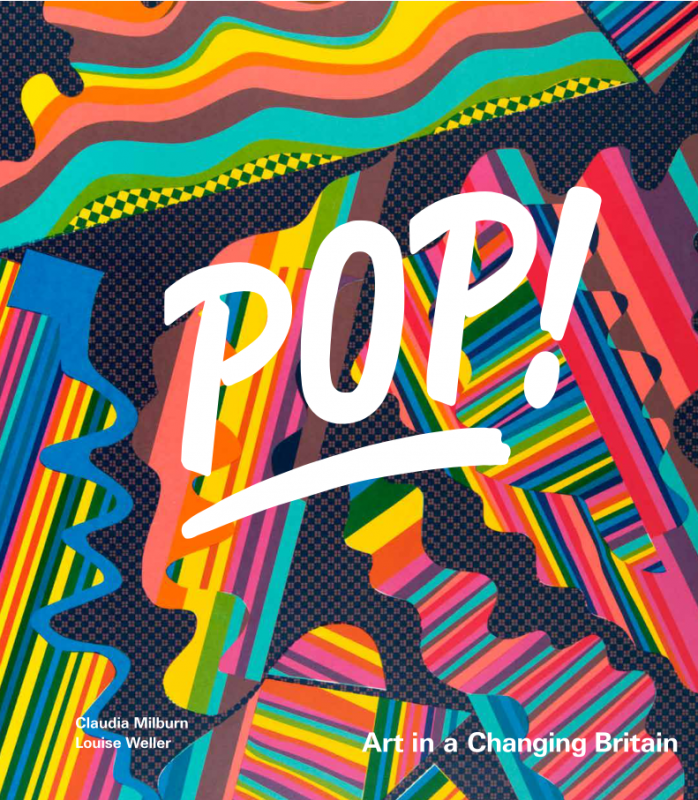
Front cover, ‘POP! Art in a Changing Britain’
This spring at Pallant House Gallery , we are celebrating the gallery’s extensive collection of British Pop Art through the major exhibition 'POP! Art in a Changing Britain' . The wide range of work represents a transformative moment in British modern art, reflecting changes in artistic discourse – largely in response to the cultural, political and social changes of the era – and a youthful challenge to established conventions. A particularly interesting area of exploration, which arose from the work within the exhibition, is the complex relationship artists have with photography and processed imagery, which we can explore through three major works from the exhibition.
Richard Hamilton, Swingeing London 67
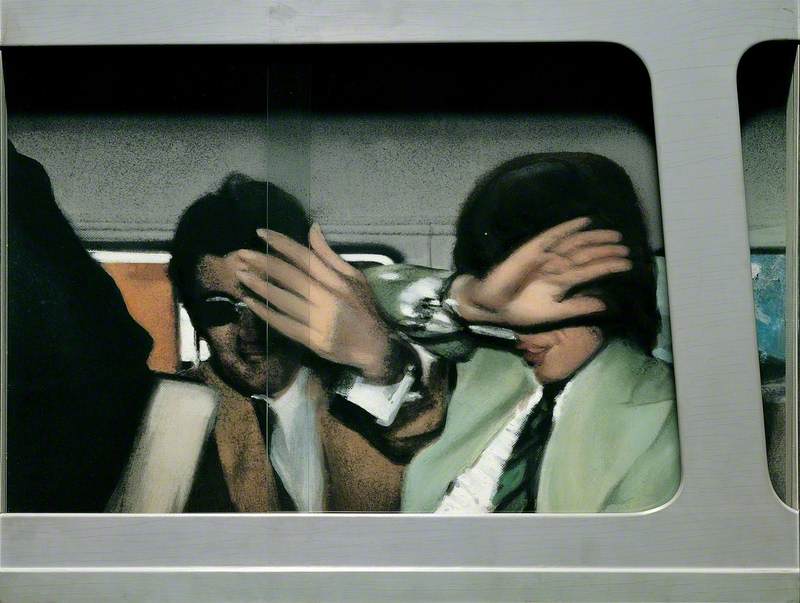
Swingeing London '67 1967–1968
Richard Hamilton (1922–2011)
In an article for Studio International in March 1969, Richard Hamilton set out his interest in the role of reportage photography, magazines, cinema and television in providing the artist with an alternative view and connection with the wider world. He noted that this ‘return to nature came at second hand through the use of magazines rather than as a response to real landscape or still-life objects or painting a person from life. Somehow it didn’t seem necessary to hold on to that older tradition of direct contact with the world. Magazines, or any visual intermediary could as well provide a stimulus.’
A paparazzi photograph reproduced in a newspaper was the departure point for this work by Richard Hamilton. Critical of the arrest and sentencing of his friend, the art dealer Robert Fraser, and lead singer of the Rolling Stones, Mike Jagger, for drug possession, Hamilton produced Swingeing London 67, combining a painted quality with a superimposed screen-print on a photograph, which refers back to the processed quality of the original newspaper image. Hamilton chose to add another layer to the experience of how the viewer understands the visual work by presenting these two figures within a constructed frame alluding to the police van window, through which the drama unfolds.
Peter Blake, Girls with Their Hero
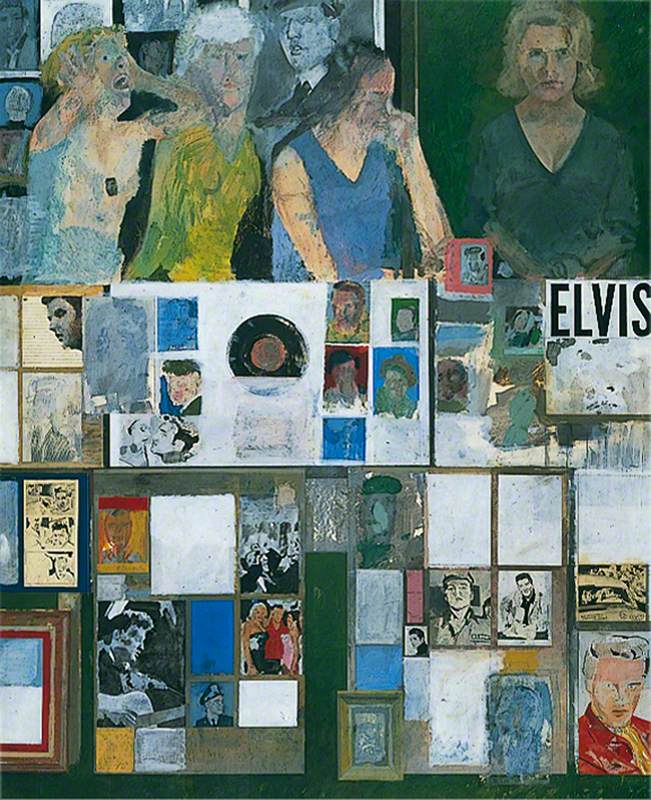
Girls with Their Hero 1959
Peter Blake (b.1932)
Celebrity icons and screaming fans epitomized the music scene of the late 1950s and 1960s on both sides of the Atlantic. In Girls and Their Hero, Peter Blake , a self-confessed fan of popular culture and ardent collector of ephemera, playfully explores the way in which we connect with celebrities. Presenting a collage of images, apparently drawn from newspapers, magazines and posters, depicting different aspects of Elvis – the soldier, the singer and the heart throb – these painted images comment on the processed nature of publicity images through which fans celebrate their heroes.
Gerald Laing, Brigitte Bardot from Baby Baby Wild Things
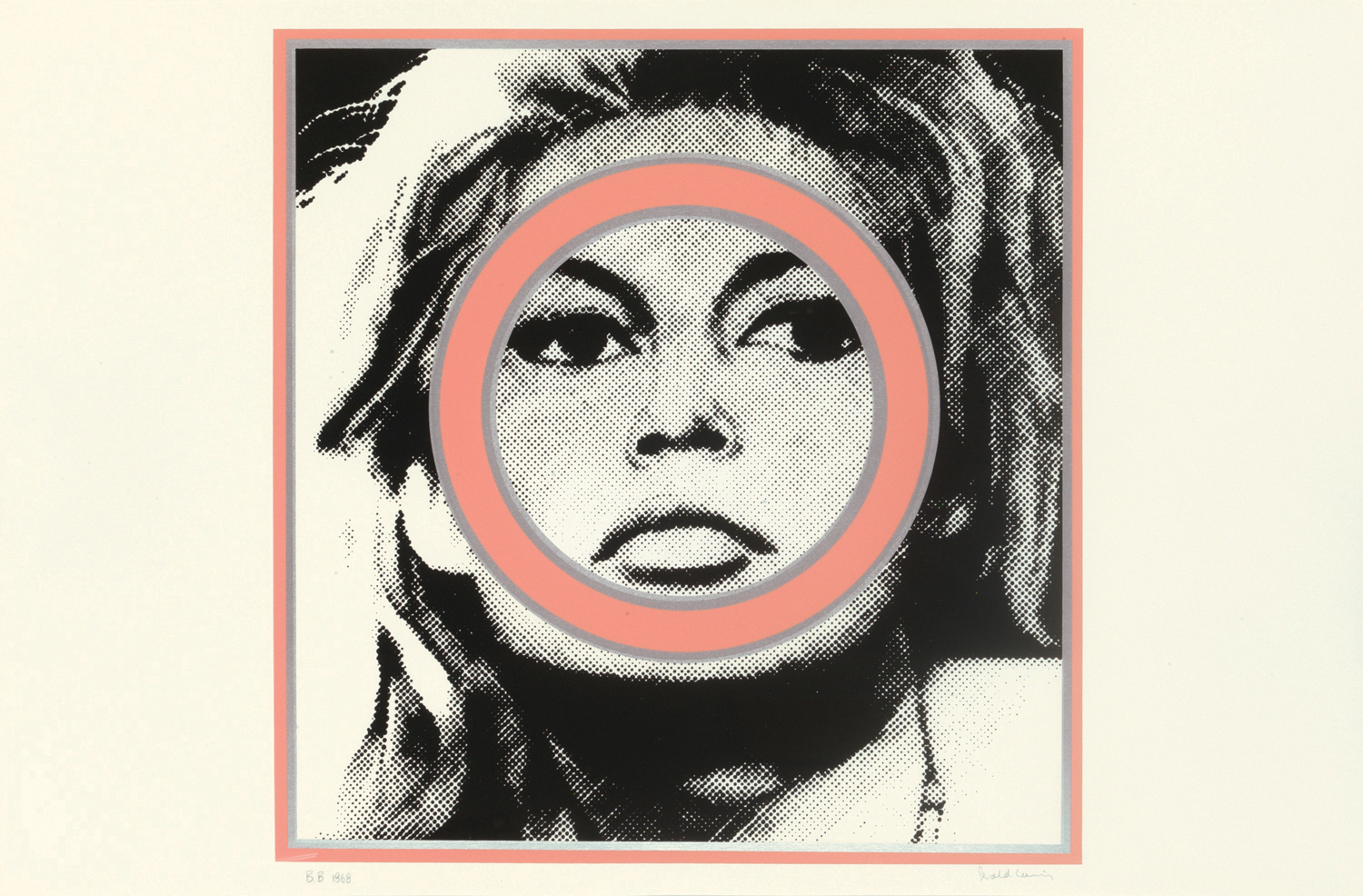
Brigitte Bardot
1968, screenprint (1/6) by Gerald Laing (1936–2011), Pallant House Gallery (on loan from Lyndsey Ingram)
In this brazen act of re-appropriation, Gerald Laing traced and then painted an image of Brigitte Bardot. The original source for the tracing was a printed publicity image used on the poster for the annual 'Young Contemporaries' exhibition, to which Laing then submitted his painting. Playing with the notion of the processed image, Laing also adopted the printed quality of the original image by building up his painting through individual ‘Ben-day’ dots. His painting was later translated into a screenprint, so extending the interdependent relationship between processed images, painting and prints. This work forms part of a portfolio of prints which we are in the process of acquiring for the collection.
As we take the opportunity to reappraise these works from a position of today’s digital, image-saturated world, it seems that more than ever we need to question and challenge the increasingly symbiotic relationship between photography, identity and art.
Louise Weller, Curator at Pallant House Gallery
Louise is co-curator of the exhibition POP! Art in a Changing Britain which runs at Pallant House Gallery until 7th May 2018
- Share on Facebook
- Share on Twitter
More stories
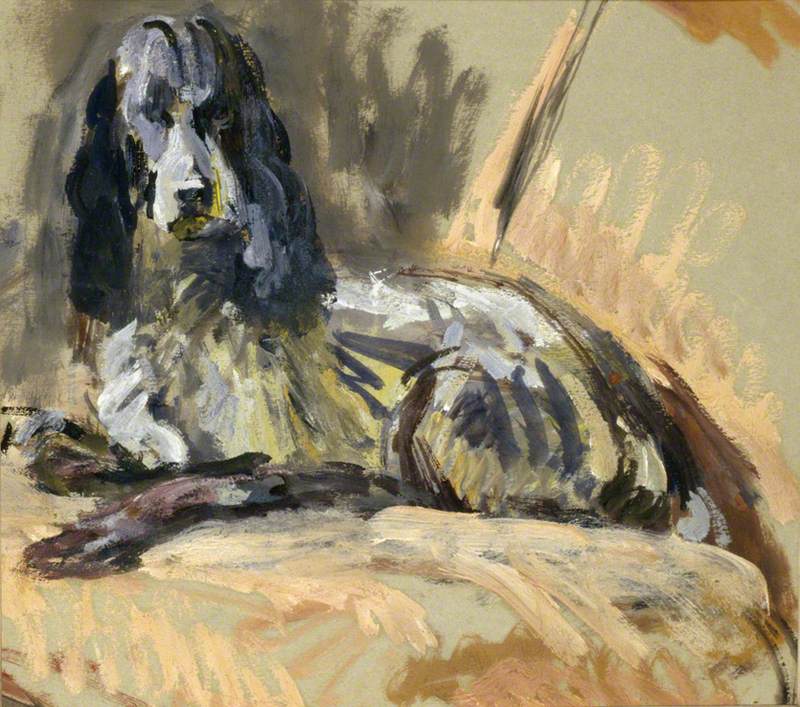
Learning resources
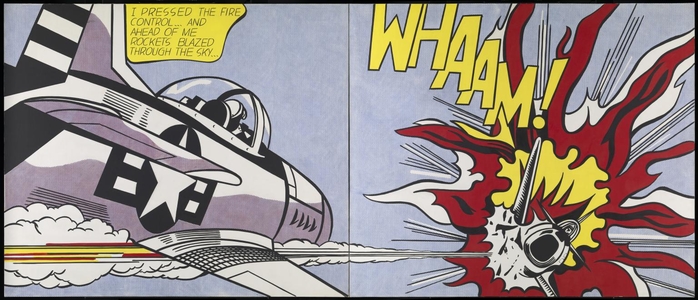
Academia.edu no longer supports Internet Explorer.
To browse Academia.edu and the wider internet faster and more securely, please take a few seconds to upgrade your browser .
Enter the email address you signed up with and we'll email you a reset link.
- We're Hiring!
- Help Center

Pop art: The art that emerged from popular culture

One of the biggest art movements of the 20th Century, Pop Art has been shaped by the demands of consumer society. In contrast to the elitist conception of art, postmodernism used popular images and became the art of consumer society. Employing images from the popular culture, it sought to elevate its objects to highbrow clientele. In this context, some saw Pop Art as a field whereby popular culture, which essentially belonged to common people, was utilised by the dominant classes to penetrate into the emotions and thoughts of people, eventually aiming to fortify their hegemony. Pop Art was defined as kitsch, decadent or banal for using the popular images from mass culture. Debates over popular culture versus high culture have started to set the tune in art theory.
Related Papers
Science Park Research Organization & Counselling
Although the conceptual definition of calligraphy is elegant handwriting formed with an aesthetic concern, it can be expressed as the reflection of artist's individuality and form of his authentic interpretations on the features of brush and line with a style of expression. The importance of the calligraphy is an undeniable fact in the finalization of writing as an art object. Writing serves a functional purpose basically. However, it is closely related with the stylistic development of different branches of art. Creation of artistic writing with an aesthetical concern comes to the fore as a feature in contrast with the formation of writing as a result of the needs of human beings. In this study, the historical development of calligraphy is analysed, its usage in today's design and importance is evaluated and the connection of its development with technology is examined by considering examples. With the detailing of the factors affecting the art of country, the effects of culture on the methods and applications are examined. Although it was developed from writing, calligraphy as an art can be defined as figurations, interpretations which perform the communication function formed by the aesthetical concerns. In this context, it is possible to speak of a form of expression in illustrations which is described as " calligraphic " a result of using the brush and lines randomly. With this study in which the necessity, technology and usage of calligraphy in graphic design is examined, it is aimed to deal with the cultural quality of education of calligraphy and its educational benefits and the teaching methods of educators will be examined in terms of quality.
Dr. Salman Alhajri
This paper investigates the position of ‘creativity’ within graphic design education in general, and within the Omani educational context in specific. Creativity is defined within this research and in relation to graphic design education as ‘problem solving’, which is explained also as a cultural activity, or a cultural production. Graphic designers can involve themselves effectively in solving communication, social, and cultural problems that are classified as ‘wicked problems’, which usually require creative solutions. It is argued that Omani graphic designers should be creative problem solvers and able to find effective solutions for these problems. Yet this is not the case in Oman, at least from the perspective of this paper. A qualitative interpretative methodology was used for this purpose. A survey approach was used, implementing two methods: questionnaires and interviews. The online questionnaire was conducted with 33 international participants. It investigated how creativity is defined within graphic design contexts; whether creativity can be taught or enhanced. The same set of questions was asked in face-to-face interviews conducted with 39 design lecturers. The interviewees were local lecturers who teach graphic design courses at some Omani institutions. All of the collected data was analyzed through a thematic analysis. As a result this paper has defined the concept of ‘creativity’ from design educational perspective, collected ideas, insights and trends about creativity in graphic design education, and has advanced knowledge of the relationships among graphic design, creativity, within Omani education system. Keywords: creativity, Omani design education, teaching creativity, problem solving, wicked problems.
The concepts of art engineering or engineer artists are apt concepts in that science and art nurture one another and that they act in parallel in some situations. The artist also benefits from several scientific disciplines in the process of art creation. Examples for art engineering include the works of Jan van Eyck and subsequent masters, who benefited from chemical engineering by using different mixtures of pigments and various oils in the creation of oil painting dating back to more than six hundred years ago and Leonardo Da Vinci, who benefited from different fields of engineering such as mathematics and mechanics, which characterized the Renaissance. In parallel, the development of industry and technology brought about a variation in the materials and techniques that can be employed and put into use by artists. As different engineering branches emerged, new concepts were also included in the literature. The word Kinetics (Kinesis) which was originally used to define only movement-related phenomena in the branches of physics and chemistry came to be used in the field of arts and it was established in the art jargon when a Kinetic Art chronology was published in the year 1960. Kinetic Art is the branch of art that probably has the highest concentration of works demonstrating the concept of 'art engineering'. This paper will purport to analyze the way in which practitioners of Kinetic Art benefited from various engineering fields in the light of findings that this movement-based art was nurtured by several fields of engineering including mechanics, mathematics, electronics and even chemistry.
The globalization is an economical, technological and social phenomenon that we may base upon many factors like the development of communication and economic reasons (market seeking etc.) based on the colonial states search of the countries which completed its industry revolution postwar , immigration of the group who are unemployed due to the mechanization, to the large cities and the international dimension of the production and commerce. It is at the same time a concept that points the dependency of the individuals and communities one another. This concept is not just related with economics, communication or commerce. It a process that grows like a balloon that takes air in it each day and includes the art and involves it into its negative or positive struggle. Today, the effort of interpreting the artworks in a different way as the result of the globalization, presents the necessity to emphasize the respect to the works and the artists as it should be. With the simplest example to portray, use " Mona Lisa " the work of Leonardo da Vinci in different shapes and to reflect these changes to the individuals as it is normal in the fast growing communication process, shows the negative effect of the globalization on art. The moustache and beard parody that Marcel Duchamp has drown in reproduction of Mona Lisa, is an attack to the selfish western middle class within today's or his own period's imperialist nostalgias, not to the artist or art. The period of this activity, is the period that the modernism has developed and moved in its most firm status. But maybe the parody of Mona Lisa which is fast spreading as the result of Marcel Duchamp taking this icon as an example, made the destruction in the globalization process unavoidable. 'The rebellion period to modernism movement that is formed with the concern to convert the tradition to global and the arrival of this rebellion to the level that probes the ethical dimension of the art brings along the inevitable concern, the concern of determining the limits of the art, artist protection and critical approach. 516 For sure the development of the technology and settlement of the communication problems is a process that glamour the human. The negative results of this process target not only the states that are being exploited but also the culture, art and artist of these states. Under these circumstances, the concern to art for the path that the art shall be followed or directed, have importance. Besides the concerns that are felt for the results of postmodernism, in this study some examples are given for showing that the postmodernism can be evaluated with its inspiration sense more of the one to one counterfeiting.
Literally posters is defined as a sign attached to the wall, printed or handwritten carried during the demonstration in order to expose the public notice. Posters to convey a message of equal weight or anxiety and are prepared graphic design and art products in order to promote a product. The purpose of this study is to determine the advantages of using illustration an painting techniques in designing traditional poster. The problems that lead the study to this aim are technological developments and that contemporary art poster designs formed with absolute photographic aesthetic are becoming monotonous. The findings of this study were tried to be obtained by two-dimensional approach. The first is literature scanning. In the second, works of artist in the determined sample were analyzed in terms of both illustrations and using of pictorial techniques. In this context, examples of the works of artists such as
The research topic is patchwork, precisely matching and unfitting of samples of knitted or crocheted textiles which can be used in interior design. In addition of being an integral and permanent part of the trends in the fashion industry, patchwork is extremely popular in design of upholstery and furniture, as interesting and desirable styling element in space. This research is focused on the research of matching of different textures (which are specifically expressible in knitted and crocheted textiles), as well as matching of colors. For each knitted and crocheted pattern data was carefully recorded. With photo, texture of the sample was described (fine, coarse) as well as construction in which the pattern was made. Numerical data on the density of stitches helped describe the texture. Color of the sample is described. Analyses of this data included setting of samples of different textures and colors side by side, or differently sad-play with patterns and patchwork assembling, and recording their matching. Outcome of play with patterns (successful combinations) are presented in the paper. Those patterns are applicable in the form of interesting fabrics for upholstery, chairs, decorative pillows, blankets, up to now very modern patchwork carpets.
The focus on imitating traditional designs among students of ceramics in Omani educational institutions has led to minimising students’ creativity. The purpose of this study is to examine the capability of Omani ceramics students to use Mondrian’s style in their ceramic art with the purpose of evaluating their ability to free themselves from traditions when they create their ceramic art. Keywords: ceramics, mondrian, traditional design, Oman.
The role of material in the act of making art takes the artist to some research about the material. Artist who use every object in the nature as a tool when transferring his/her expression to viewers, handles and turns the objects that s/he founds or ready to handle materials in accordance with the theme of his/her design and tries to make them compatible and conforming for his/her purpose, aim and interpretation. Manufacturing the ready to handle objects by handwork or use of industrial methods by only changing the material is an artistic stance adopted by many artists from past to present. Artists have demonstrated their reaction and respond against the previous understanding of art, technology and consumption through methods such as exhibiting daily objects as they are, imitating them simply by use of plastic materials or re-manufacturing them with a hyper-realistic reaction. The importance of material is great and high in these attitudes. Ceramic clay which is the material gives its name to Ceramic Art has become one of the most important materials on which scientists and artists work intensely together with the contributions of technology and industry in this direction. The purpose of artist in processing his/her clay different from scientists is to strengthen the artistic expression rather than to achieve industrial excellence. The artist of the artwork researches, chooses or produces the material appropriate for his/her artwork that s/he had designed or benefits from the blessings of the material that s/he founds and shapes his/her opinion, idea or artwork according to the structure of the material in his/her hand. The unique and specific material production idea has been supported in this study which is about clay manufacturing for 355 personal ceramic designs with artistic purposes and the study is presented after making assessments of personal design and implementation samples technically and artistically.
The purpose of this study is to examine the significance of the studies of the Hungarian composer and ethnomusicologist Bela Bartok, which became a basis for the ethnomusicology studies in Turkey during the nation state formation process starting with the establishment of the Republic in line with Turkish music revolution ideology. Nationalism, preservation of the traditional music, emphasizing the dominant ethnic identity, including folk music in the training music gained a place in the Turkish music life with the help of Bartok's studies. Thus, the aspects of the relationship of Bela Bartok's Turkey compilations to the music revolution in Turkey and the national music ideology, the importance of Bartok and his compilation styles in revealing the national and local music and his field researches' forming a basis for the ethnomusicology studies will be discussed in the scope of folk music studies in line with this purpose.
Science Park Research Organization & Counselling , zekiye cildir
Modern approach evolved modern museums as dialogue centres which make close contact with visitors based on learning in order to present its exhibition objects. Along with twenty first century, being one of the most important places among the social functions of museums, " education " has almost been one of the traditional functions of them. Besides the educational facilities which museums provide visitors, they should also develop their physical structures in a contemporary line, and reconsider them in a way that highlights individual experience and visitor interaction during the time spent in there. In order to maximize interaction between visitors and museums, museum education which is developed by using pedagogical methods and grounding on various values, concepts and information has a close relation with visual culture that is an interdisciplinary concept. Visual culture has put popular objects into museums and been an important subject on which modern museums focused in order to provide their sustainability. Modern museums produce information and aim to spread information to all classes in a society by using educational activities; also when they are considered as living places, they are used to practice the functions of visual culture. These practices have been helpful for developing information technologies in museums especially for the last thirty years and, resulted in implementing a structural reform and revisions in regard to integrating these technologies with museum perception. In the frame of these revisions, online technologies, simulations, interactive presentations and digital exhibitions are at the first place. These chances that took place in museums have been the source for from the collections of these institutions to their policies and also from the use of human resources to digitalizing of their activities. The purpose of this study is to identify the visual culture activities which take place in modern museums in the framework of educational activities, and to display practice samples in Turkish museums in detail. The study is a result of a descriptive survey model research that contains samples regarding 81 visual culture practices in the world and Turkish museums. The study is limited with state and private museums which are tied to Turkish Republic Ministry of Culture and Tourism and inspected by the relevant ministry. Visual culture practices that took place in these museums are gathered by using structured interview forms and commented by analyzing content analysis.
RELATED PAPERS
Müge Burcu Codur
Nilgün Kuloğlu
Ali Akin Akyol
Science Park Research Organization & Counselling , Aysem Tombak
Science Park Research Organization & Counselling , Yasemin Erengezgin Kafkas
Science Park Research Organization & Counselling , zafer sagdic
New Trends and Issues Proceedings on Humanities and Social Sciences
New Trends and Issues Proceedings on Humanities and Social Sciences (PROSOC)
Science Park Research Organization & Counselling , Dogan Arslan , Ertan Toy
Science Park Research Organization & Counselling , Ceyda Alparslan
Science Park Research Organization & Counselling , Ayşegül Gürdal Pamuklu
Global Journal on Humanities and Social Sciences
Sandra Castañeda Figueiras
RELATED TOPICS
- We're Hiring!
- Help Center
- Find new research papers in:
- Health Sciences
- Earth Sciences
- Cognitive Science
- Mathematics
- Computer Science
- Academia ©2024
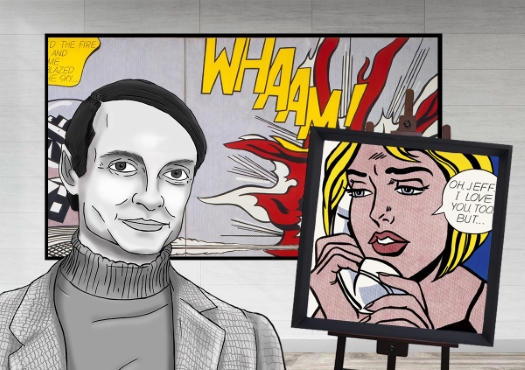
Roy Lichtenstein
American Painter, Sculptor, and Lithographer

Summary of Roy Lichtenstein
Roy Lichtenstein was one of the first American Pop artists to achieve widespread renown, and he became a lightning rod for criticism of the movement. His early work ranged widely in style and subject matter, and displayed considerable understanding of modernist painting: Lichtenstein would often maintain that he was as interested in the abstract qualities of his images as he was in their subject matter. However, the mature Pop style he arrived at in 1961, which was inspired by comic strips, was greeted by accusations of banality, lack of originality, and, later, even copying. His high-impact, iconic images have since become synonymous with Pop art, and his method of creating images, which blended aspects of mechanical reproduction and drawing by hand, has become central to critics' understanding of the significance of the movement.
Accomplishments
- Art had carried references to popular culture throughout the 20 th century, but in Lichtenstein's works the styles, subject matter, and techniques of reproduction common in popular culture appeared to dominate the art entirely. This marked a major shift away from Abstract Expressionism , whose often tragic themes were thought to well up from the souls of the artists; Lichtenstein's inspirations came from the culture at large and suggested little of the artist's individual feelings.
- Although, in the early 1960s, Lichtenstein was often casually accused of merely copying his pictures from cartoons, his method involved some considerable alteration of the source images. The extent of those changes, and the artist's rationale for introducing them, has long been central to discussions of his work, as it would seem to indicate whether he was interested above all in producing pleasing, artistic compositions, or in shocking his viewers with the garish impact of popular culture.
- Lichtenstein's emphasis on methods of mechanical reproduction - particularly through his signature use of Ben-Day dots - highlighted one of the central lessons of Pop art, that all forms of communication, all messages, are filtered through codes or languages. Arguably, he learned his appreciation of the value of codes from his early work, which drew on an eclectic range of modern painting. This appreciation may also have later encouraged him to make work inspired by masterpieces of modern art; in these works he argued that high art and popular art were no different: both rely on code.
The Life of Roy Lichtenstein
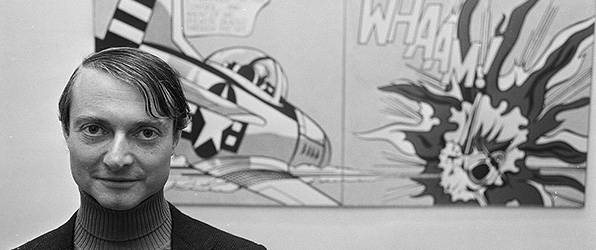
Lichteinstein was led to to put a microscope to his surroundings, to pursue a lifelong inquiry that he summarized thus: "I'm interested in portraying a sort of antisensibility that pervades society."
Important Art by Roy Lichtenstein
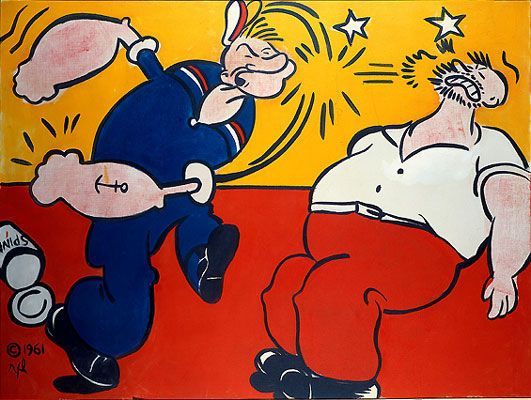
Popeye was one of the very first Pop paintings that Lichtenstein created in the summer of 1961. At a later stage he would begin to focus on the generic human figures that appeared in cartoons of the period, but, early on, he chose immediately recognizable characters such as Mickey Mouse and Popeye (here, Popeye appears with his rival Bluto). The work is also distinct in being one of the last in which Lichtenstein actually signed his name on the surface of the picture; critic Michael Lobel has pointed out that he seems to have done so with increasing uncertainty in this piece, combining it with a copyright logo that is echoed in the form of the open tin can above it. Some have suggested that Popeye's punch was intended as a sly response to one of the reigning ideas in contemporary art criticism that a picture's design should make an immediate visual impact. Whereas most believed this should be achieved with abstract art, Lichtenstein here demonstrated that one could achieve it just as well by borrowing from low culture.
Oil on canvas, © Estate of Roy Lichtenstein
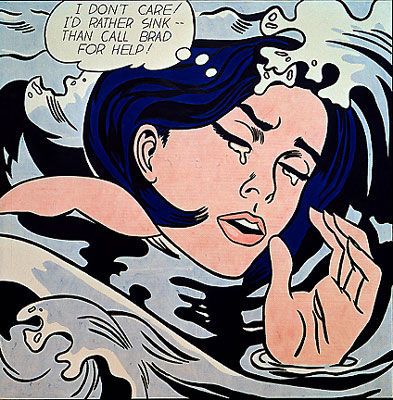
Drowning Girl
In the early 1960s, Lichtenstein gained renown as a leading Pop artist for paintings sourced from comic books, specifically DC Comics. Although artists such as Robert Rauschenberg and Jasper Johns had previously integrated popular imagery into their works, no one hitherto had focused on cartoon imagery as exclusively as Lichtenstein. His work, along with that of Andy Warhol, heralded the beginning of the Pop art movement, and, essentially, the end of Abstract Expressionism as the dominant style. Lichtenstein did not simply copy comic pages directly, he employed a complex technique that involved cropping images to create entirely new, dramatic compositions, as in Drowning Girl , whose source image included the woman's boyfriend standing on a boat above her. Lichtenstein also condensed the text of the comic book panels, locating language as another, crucial visual element; re-appropriating this emblematic aspect of commercial art for his paintings further challenged existing views about definitions of "high" art.
Oil and synthetic polymer paint on canvas, © Estate of Roy Lichtenstein - The Museum of Modern Art, New York
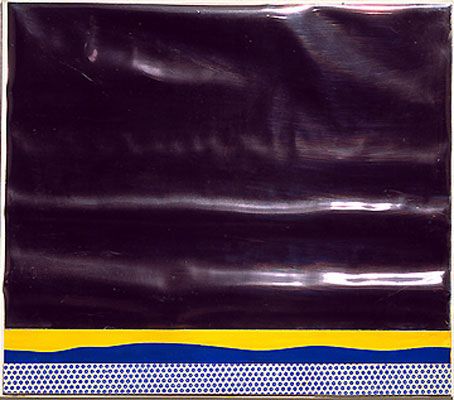
Yellow Landscape
Lichtenstein expanded his use of bold colors and Ben-Day dots beyond the figurative imagery of comic book pages, experimenting with a wide variety of materials; his landscape pictures are a particularly strong example of this interest. Lichtenstein made a number of collages and multi-media works that included motors, metal, and often a plastic paper called Rowlux that had a shimmery surface and suggested movement. By re-appropriating the traditional artistic motif of landscape and rendering it in his Pop idiom, Lichtenstein demonstrated his extensive knowledge of the history of art and suggested the proximity of high and low art forms. His interest in modern art also led Lichtenstein to create many works that directly referenced artists such as Cézanne, Picasso, and Matisse.
Rowlux and oil on paper, © Estate of Roy Lichtenstein - Kunstmuseum, St. Gallen, Switzerland
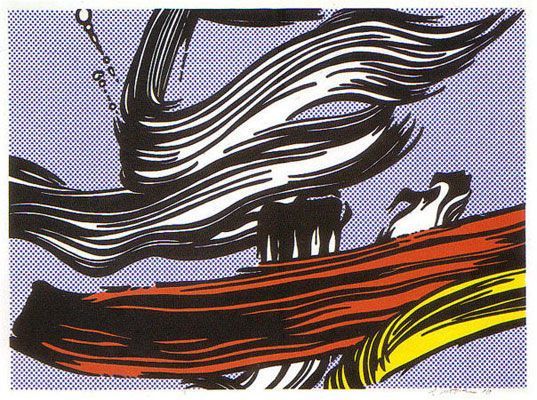
Brushstrokes
Lichtenstein was a prolific printmaker throughout his career, and his prints played a substantial role in establishing printmaking as a significant art form in the 1960s. Brushstrokes , one such print, reflects his interest in the importance of the brushstroke in Abstract Expressionism. Abstract Expressionist artists had made the brushstroke a vehicle to directly communicate feelings; Lichtenstein's brushstroke made a mockery of this aspiration, also suggesting that though Abstract Expressionists disdained commercialization, they were not immune to it - after all, many of their pictures were also created in series, using the same motifs again and again. Lichtenstein has said, "The real brushstrokes are just as pre-determined as the cartoon brushstrokes."
Color screenprint on white wove paper, © Estate of Roy Lichtenstein - The Art Institute of Chicago
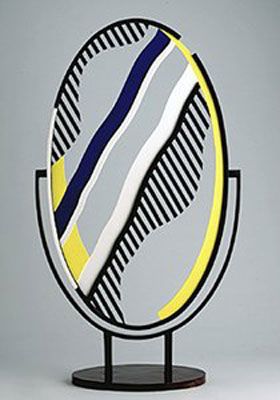
Lichtenstein was particularly fascinated by the abstract way in which cartoonists drew mirrors, using diagonal lines to denote a reflective surface. He once remarked, "Now, you see those lines and you know it means 'mirror,' even though there are obviously no such lines in reality. It's a convention that we unconsciously accept." The mirror was a recurring leitmotif for Lichtenstein during the 1970s, but the artist had experimented with the graphic representation of reflection in earlier works, driven in part by an interest in the relationship between women and mirrors - both in historical artworks and in contemporary culture. Although the series might have been inspired by the appearance of mirrors in cartoons, Lichtenstein clearly also wanted to engage with themes of reproduction and reflection, which have interested artists at least as far back as the Renaissance.
Painted bronze, © Estate of Roy Lichtenstein - San Francisco Museum of Art, San Francisco, CA

Public and outdoor artworks, both painting and sculpture, constitute a significant portion of Lichtenstein's work, starting with a mural painted for the 1964 World's Fair in Queens, New York. The large-scale sculpture House I plays with perspective and illusion: depending on where the viewer stands, he or she will see the building's corner appear to move forward or backward within space. Despite Lichtenstein's typical use of flat colors and the fact that this sculpture is really a flat piece of metal, the structure's design lends a sense of volume. He produced several House sculptures, all of which can be connected to Lichtenstein's interest in the interiors of buildings, a subject he visited most explicitly in his later work.
Fabricated and painted aluminum, © Estate of Roy Lichtenstein - The National Gallery of Art, Washington DC
Biography of Roy Lichtenstein
Roy Fox Lichtenstein was born in New York City in a family with a German-Jewish background. He grew up on the Upper West Side of Manhattan with his father Milton, a real-estate broker, his mother Beatrice, a homemaker, and his younger sister Renee. As a child, Lichtenstein spent time listening to science fiction radio programs, visiting the American Museum of Natural History, building model airplanes, and drawing. As a teenager he nurtured his artistic interests by taking watercolor classes at Parsons School of Design, and in high school he started a jazz band.
Early Training
In 1940, Lichtenstein began taking Reginald Marsh's painting classes at the Art Students League , producing work very similar to Marsh's social realist style. Later that year, Lichtenstein enrolled at Ohio State University (OSU), where he studied drawing and design along with botany, history, and literature. He created sculptural animal figures, as well as portraits and still life works influenced by the work of Pablo Picasso and Georges Braque . At OSU, Lichtenstein also took a class with Hoyt Leon Sherman, whose theories about the connection between vision and perception, or "organized perception," became important concepts for Lichtenstein as his work evolved.
In 1943, Lichtenstein was drafted into the Army. As part of his tour of duty, he took engineering courses at De Paul University in Chicago. He also served as a clerk and draftsman, enlarging army newspaper cartoons for his commanding officer. He then traveled with the Army to England, France, Belgium, and Germany. After receiving an honorable discharge in 1946, the artist returned to OSU to complete his Bachelor's degree in Fine Arts. The next year he joined the graduate program at the University and served as an art instructor. His art at this time was inspired by aspects of Abstract Expressionism and biomorphic Surrealism .
In the next several years his work was included in gallery shows, such as a group exhibition at the Ten-Thirty Gallery in Cleveland, where he met his future wife Isabel Wilson, the gallery assistant at Ten-Thirty. By this stage, his paintings featured musicians, street workers, and racecar drivers rendered in biomorphic shapes and in a style that recalled the Surrealist work of Paul Klee . Over the next several years, Lichtenstein's paintings featured birds and insects in this same Surrealist style, as well as medieval motifs, particularly imagery of knights and dragons. In addition to strictly two-dimensional paintings, Lichtenstein began nurturing what would become a long-standing interest in using multiple media; in his first solo show in New York, at Carlebach Gallery (1951), he exhibited three-dimensional assemblages of kings and horses made of wood, metal, and found objects.
Mature Period
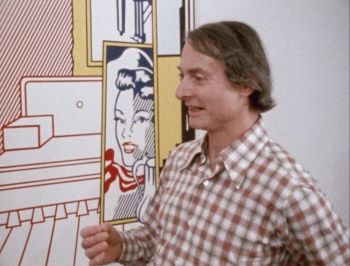
After moving to Cleveland with Isabel, Lichtenstein took on a number of commercial engineering and drafting jobs. His work at this time focused on cowboy and Native American motifs; more significantly, he created a rotating easel to be able to easily paint from all angles. The method of working (the rotation of the canvas) was more compelling to Lichtenstein: "I paint my own pictures upside down or sideways. I often don't even remember what most of them are about... The subjects aren't what hold my interest." In 1952, John Heller Gallery in New York began representing his work. Lichtenstein took an assistant professor position at SUNY Oswego in 1957, where his thickly textured paint and abstracted imagery drew from the Abstract Expressionist style. Unlike the Abstract Expressionists, however, he began to incorporate figures into his canvases; some of his paintings featured characters such as Donald Duck and Mickey Mouse hidden among the other depicted forms. Lichtenstein continued to teach, moving on to Rutgers's Douglass College in 1960 as an assistant professor, where he met Allan Kaprow . Kaprow introduced Lichtenstein to Claes Oldenburg , Lucas Samaras , Robert Watts , George Segal , Robert Whitman and others who were integral members of the " happenings " art scene of the 1950s and 60s. The group produced unique performative art pieces that differed each time depending on audience involvement, but Lichtenstein was inspired by their interest in cartoon imagery.
In 1961, Lichtenstein created Look Mickey , his first cartoon work using Ben-Day dots, a commercial printing style for comic books or illustrations where small, closely spaced, colored dots are combined to create contrasting colors. He later exaggerated these dots in his paintings, a technique that came to define his style. The technique he developed at this time blended aspects of hand-drawing and mechanical reproduction; by 1963 he had settled on a procedure by which he first reproduced the chosen panel from a cartoon by hand, then projected the drawing using an opaque projector, traced it onto a canvas, then filled in the image with bold colors and stenciled Ben-Day dots.
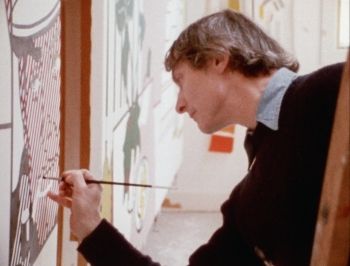
In 1961, gallery owner Leo Castelli began representing Lichtenstein's work, giving him a solo exhibition in 1962 that substantially elevated the artist's renown and revenue. His fame did not come without controversy; his compositions outraged some viewers, and prompted LIFE Magazine to call him "one of the worst artists in America," albeit in a tongue-and-cheek fashion. Nevertheless, Lichtenstein soon began to show his work in major national exhibitions. In the 1960s, he continued using the Ben-Day dot technique in images of women and WWII combat scenes, as in Drowning Girl (1963), mostly adapted from issues of DC Comics. These cartoon-inspired paintings established Lichtenstein as an extremely prominent and immediately recognizable Pop art figure, both revered and reviled for his challenges to traditional understandings of "fine art."
By the mid 1960s, Lichtenstein began creating large-scale murals, his first of which was produced in 1964 for the World's Fair in Flushing, Queens. Moving beyond figural depictions, Lichtenstein also broadened his use of Ben-Day dots and bold, solid colors to depict landscapes, as in Yellow Landscape (1965). Such works often integrated industrial materials such as Plexiglas, metal, and a shimmery plastic called Rowlux, reflecting the artist's continued interest in using media beyond simply paint and canvas. Lichtenstein also began to create ceramic sculptures and, most iconically, produced a series of paintings of giant, cartoon-like brushstrokes covering the canvas, images which seemed to mock the Abstract Expressionists' use of the brushstroke as a signature and tool of individual expression. The second half of the 1960s also marked Lichtenstein's separation from his wife Isabel, and, a few years later, his marriage to Dorothy Herzka.
Lichtenstein began producing prints in 1962, using the offset lithograph technique that was more often used in commercial printing, and he began a long-term collaboration with the printmaking studio Gemini G.E.L. in 1969. In the 1970s, he left New York City for Southampton, where, inspired by Modern masters, he created still lifes and works with diverse textures and materials. Sculpture became an important focus during this time, particularly the use of bronze, which he used to produce large, painted sculptures of everyday objects such as lamps, pitchers, and steaming coffee cups. Lichtenstein also created a series of paintings involving mirrors, inspired by the historical use of mirror imagery in paintings to create a space beyond the canvas, as well as by the abstract designs used to symbolize mirrors in graphic art.
Late Period

By 1980, Lichtenstein was drawing from a wide variety of influences in his work, taking inspiration from Surrealism , Cubism , and German Expressionism , and using many different types of media. He re-established a studio in Manhattan and became more interested in Abstract Expressionism , as well as in Geometric Abstraction . He created a series of home interiors in the 1990s, basing his designs on ads in the Yellow Pages. Additionally, he continued to produce large paintings and sculptures for public spaces. In 1995, he received the National Medal of Arts. After his death in 1997, the Roy Lichtenstein Foundation was established in 1999.
The Legacy of Roy Lichtenstein

Roy Lichtenstein played a critical role in subverting the skeptical view of commercial styles and subjects established by the Abstract Expressionists. By embracing "low" art such as comic books and popular illustration, Lichtenstein became one of the most important figures in the Pop art movement. While his paintings of cartoons and comics are his most recognizable work, he had a prolific and somewhat eclectic career that drew from Cubism, Surrealism, and Expressionism. But it is his re-imagining of popular culture through the lens of traditional art history that has remained a considerable influence to later generations of artists, as Pop art went on to significantly inform Postmodernism .
Influences and Connections

Useful Resources on Roy Lichtenstein

- Roy Lichtenstein (1994) Guggenheim Exhibition Catalogue / By Diane Waldman
- Roy Lichtenstein: Classic of the New Our Pick By Eckhard Schneider
- Lichtenstein: Girls By Richard Hamilton, Jeff Koons, Dorothy Lichtenstein, Richard Prince
- Roy Lichtenstein: Prints 1956-1997 By Elizabeth Brown, Dave Hickey, Roy Lichtenstein, Chris Bruce
- Roy Lichtenstein: Interiors By Robert Fitzpatrick, Dorothy Lichtenstein
- Roy Lichtenstein: Brushstrokes, Four Decades By Dave Hickey, Roy Lichtenstein
- Image Duplicator: Roy Lichtenstein and the Emergence of Pop Art Our Pick By Michael Lobel
- Roy Lichtenstein: Conversations With Surrealism By Charles Stuckey, Roy Lichtenstein, Frederic Tuten, Jack Cowart
- Roy Lichtestein Foundation Our Pick
- Deconstructing Roy Lichtenstein Comic book sources for many Lichtenstein works
- PORTRAITS, Talking with Artists at the Met, The Modern, The Louvre and Elsewhere (excerpt) By Michael Kimmelman
- Roy Lichtenstein: a new dimension in art By Lucy Davies / The Telegraph / November 17, 2008
- The Painter Who Adored Women By Roberta Smith / The New York Times / June 11, 2008
- Time Reveals the Delicacy Within Lichtenstein's Playful Pop By Michael Kimmelman / The New York Times / November 30, 2001
- Roy Lichtenstein, Pop Master, Dies at 73 Our Pick By Michael Kimmelman / The New York Times / September 30, 1997
- Roy Lichtenstein - BBC - January 1966 Interview with Lichtenstein and David Sylvester
- NPR - 29 September 1997 Lichtenstein Obit
- NPR - 4 October 2002 (interview originally from 1993) Late American Artist Roy Lichtenstein
- Times Square Mural, 2002 (Collage 1990, fabricated 1994) Times Square-42 nd Street Subway Station / Wall of N, Q, R, S, W, 1, 2, 3 mezzanine / New York, NY
- Borbonese-Lichtenstein Bags
Similar Art

Large Nude in a Red Armchair (1929)
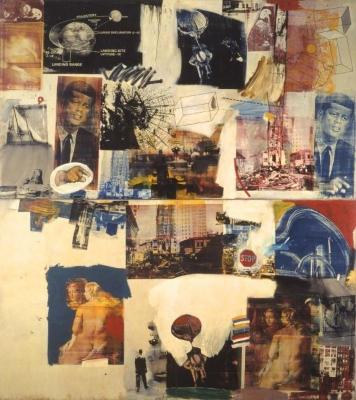
Skyway (1964)
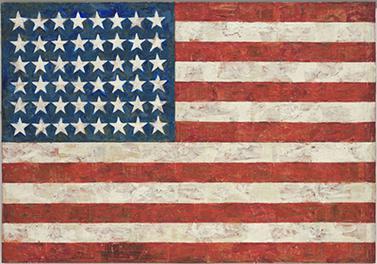
Flag (1954-55)
Related artists.

Related Movements & Topics

Content compiled and written by Rachel Gershman
Edited and published by The Art Story Contributors
pop art Recently Published Documents
Total documents.
- Latest Documents
- Most Cited Documents
- Contributed Authors
- Related Sources
- Related Keywords
A Study on the Parody Property of Pop Art Appeared in Advertisement
Commercialization of art in the context of consumption culture.
The Enlightenment philosophy, inspired by the intellectual movements of the Renaissance and Reformation, emerging from the scholastic darkness of the Middle Ages, led to the emergence of the Industrial Revolution with its strong light; With the great acceleration given by the production, it has become the dominant ideology of science, culture and art by spreading first to Europe and then to the whole world. Modernism, which was shaped by the idea of Enlightenment, transformed into capitalism in a short time and caused the formation of a consumption culture. The enlightenment ideology brought the understanding of "objective reason" and "progressive history" to humanity, which transformed it into a consumer society shaped by capitalism instead of the "promised paradise". This is why the 'Age of Modernity' is called the age of capitalist transformation. The spread of capitalism to the whole world has been achieved through mass communication and production techniques. TVs, which are the broadcasting organs of capitalism, have become the main tool of capital transformation and have ensured the spread of consumption culture with advertising and marketing techniques. Modernism has carried the material, thinking and comprehension stages of art to a materialistic dimension within a structure that is far from emotional, formed by a technocentric and mechanical mentality. Art integrated with technology has become commodified with capitalist regulation and institutionalization; has gained a commercial dimension. Pop Art, which emerged in the 1960s, has become the symbol of commercialized art; It has emerged as an art movement that deals with the consumption society and its values. Andy Warhol, the famous representative of Pop Art, is one of the artists known to play a role in the commodification of works of art. Warhol's art has made serious contributions to the process of transforming today's art into commodity aesthetics. Meta art/aesthetics is a tradeable world of copies. This artificial world has turned into the real world in the consumer society, which can be reproduced in line with the possibilities of art production technologies; They have become objects of consumption whose uniqueness has been lost. Keywords: Art, Consumption Culture, Commercialization, Kitsch, Andy Warhol
Artistic and aesthetic characteristics of vocal and pop performance as a genre synthesis of arts
The purpose of the article is to study the artistic and aesthetic features of vocal and pop art as a genre synthesis of arts. The research methodology involves the use of system-structural, comparative methods of analysis and culturological and art approaches in the study of these issues. The scientific novelty of the work is to expand the theoretical boundaries of understanding vocal and pop performance as a synthetic genre that combines different arts, and its defining artistic and stylistic features that directly affect the structure and stylistic features of vocals, interpretation of the work, its perception by listeners and representation of values, ideas and impressions generated in the process of performance and its perception. Conclusions. Conclusions. Variety vocal performance as a kind of musical text involves special manifestations of intertextuality, so it is possible to find layers of artistic and species series, expressive forms and meanings, artistic and linguistic means and interpretive techniques. From the point of view of specific tasks of artistic communication, it appears as a generalized form of musical and artistic activity that can claim universality and has its stage and staging canons, determined by value concepts of culture, but in their new popular sense. There are also exemplary compositional and semantic models in this field, the imitation of which is a recognized way to join the pop vocal and performing professionalism. In the field of pop and vocal performance in its theatrical and staged form there is a specific mythologizing, which concerns the figure of the singer as the central actor of the concert program, which forms a certain image to achieve extreme artistic persuasiveness. Therefore, it is not an image of a fictional character, but of a person close in time and meaning to life, as she can and should be in virtual artistic reality - aesthetically sublime and morally balanced. The main components of the intertextual sphere, which is formed around the variety show and determines the special director's interest in it, are semantic positions on the singer as a semantic core of the whole moving picture of pop and stage action. It is these semantic factors that organize and lead to a holistic artistic result all the structural indicators of pop performance. Keywords: vocal and pop art, artistic and aesthetic characteristics, genre specifics, genre synthesis of arts.
The Art of Everyday Objects: A Non-Invasive In Situ Investigation of Materials and Techniques of Italian Pop Art Paintings on Aluminium
Two paintings, made on aluminium support by Silvio Pasotti (among the major exponents of 1960s Italian pop art) were investigated in a totally non-invasive manner to identify the materials used by the artist. Raman spectroscopy, Fourier-transform infrared spectroscopy (FTIR), visible reflectance spectroscopy, and spectrofluorimetry with visible excitation were exploited as molecular analysis techniques, which are particularly suitable to recognise also synthetic organic materials, such as pigments and binders. The effectiveness of this multi-analytical approach was demonstrated, leading to the identification of several synthetic organic pigments, both conventional and “special effect” ones, introduced during the first half of the 20th century, as well as some well-established inorganic ones. Combining FTIR results both in the medium and near IR ranges, considerations regarding the binders employed by the artist could also be made, suggesting the use of both nitrocellulose and acrylic paints. Imaging techniques, such as IR reflectography, false colour IR, UV induced fluorescence, and portable microscopy, were also used to achieve a better knowledge of the painting practice.
Marilyn’s Dyptich: The Evolution of the Image from Pop Art to Thrash Art (to the 95th Anniversary of the Birth of the Actress)
Marilyn Monroe is already a mass culture personage. Andy Warhol created an image that removes us from the original source, on the basis of impressions associated with the life of a real person. The diptych has turned into a kind of template that can be easily filled with different meanings. The author of the article reflects on the characteristic features of this template, which is often used by contemporary artists to reproduce. The question of the citation of this diptych in the culture of the second half of the 20th century is quite well studied. But the experience of a specific kind of appropriation of this image by artists of the new millennium has already accumulated. Among them, the masters of thrash art are of particular interest: Vik Muniz and Jane Perkins. It is significant that they do not refer to the numerous photographic and film images of Marilyn Monroe. They refer specifically to the template created by Andy Warhol. They play with it, translating the substantive problems of this famous diptych into the plane of design.
Linen Boxes and Slices: Raoul De Keyser and American Modernism in Belgium in the 1960s and 1970s
Before his international breakthrough shortly before the turn of the century, Belgian painter Raoul De Keyser (1930–2012) had a long career that reaches back to the 1960s, when he was associated with Roger Raveel and the so-called Nieuwe Visie (New Vision in Dutch), Belgium’s variation on postwar figurative painting that also entails Anglo-Saxon Pop Art and French nouveau réalisme. Dealing with De Keyser’s works of the 1960s and 1970s, this article discusses the reception of American late-modernist art currents such as Color-Field Painting, Hard Edge, Pop Art, and Minimal Art in Belgium. Drawing on contemporaneous reflections (by, among others, poet and critic Roland Jooris) as well as on recently resurfaced materials from the artist’s personal archives, this essay focuses on the ways innovations associated with these American trends were appropriated by De Keyser, particularly in the production of his so-called Linen Boxes and Slices. Made between 1967 and 1971, Linen Boxes and Slices are paintings that evolved into three-dimensional objects, free-standing on the floor or leaning against the wall. Apart from situating these constructions in De Keyser’s oeuvre, this article interprets Linen Boxes and Slices as particular variations on Pop Art’s fascination for consumer items and on Minimalism’s interest in the spatial and material aspects of “specific objects”.
Ginevra Addis, The Re-identification of Pop Art: its Reception from an Italian Perspective
Variety and vocal art in the context of development mass culture.
The aim of the work is to study pop and vocal art in the context of the development of mass culture, which is genetically determined and mediated by a number of its characteristics and traits. The research methodology involves recourse to an interdisciplinary approach, as well as the use of comparative, historical and logical methods of analysis and culturological approach in the study of these issues. The scientific novelty lies in the expansion of information on the development of pop and vocal art in the context of mass culture and the mediation of its main characteristics by the formats of mass art. Conclusions. The study found that the modern system of pop art, combined with the show business, reflects the state, trends and prospects of pop music, which can be improved by understanding the socio-cultural significance of mass culture and popular art, as well as a developed sense of responsibility the creators of mass culture. The development of musical variety should be based on the generalization of previous creative experience and inherited compositional and performing traditions. The current realities of socio-cultural life determine the fact that the substantive and professional components of pop music should be based on both traditional artistic and aesthetic ideas and the search for new views on art, relevant to modern trends, tendencies and spiritual needs of society. The intensification of the musical-performing process leads to the discovery of new horizons of mastering the artistic and creative space, which, in turn, will help update the paradigm of pop art, focusing on modern pop music as an important phenomenon of socio-cultural life.
Interplay of Things
In Interplay of Things Anthony B. Pinn theorizes religion as a technology for interrogating human experiences and the boundaries between people and other things. Rather than considering religion in terms of institutions, doctrines, and creeds, Pinn shows how religion exposes the openness and porousness of all things and how they are always involved in processes of exchange and interplay. Pinn examines work by Nella Larsen and Richard Wright that illustrates an openness between things, and he traces how pop art and readymades point to the multidirectional nature of influence. He also shows how Ron Athey's and Clifford Owens's performance art draws out inherent interconnectedness to various cultural codes in ways that reveal the symbiotic relationship between art and religion as a technology. Theorizing that antiblack racism and gender- and class-based hostility constitute efforts to close off the porous nature of certain bodies, Pinn shows how many artists have rebelled against these attempts to counter openness. His analyses offer a means by which to understand the porous, unbounded, and open nature of humans and things.
Del objeto al espacio. La «indisciplina» de Christo and Jeanne-Claude
En Christo and Jeanne-Claude se aprecia un salto conceptual de las primeras obras a los últimos proyectos. Vamos a comprobar cómo buscan trascender los límites disciplinares en un proceso de evolución que apenas dura veinte años. Nos centraremos en finales de los cincuenta y la década de los sesenta. En una primera etapa, que corresponde a su periodo de residencia en París, entienden el arte de una manera objetual. Un arte de vanguardia que tiene de referencia a figuras como Picasso y Duchamp. En un segundo momento, su idea transita del objeto al espacio artístico. Un cambio de mentalidad que coincide con un cambio de residencia. De París se trasladan a Nueva York, dónde descubrirán las posibilidades del espacio y trabajarán bajo la influencia de artistas como Pollock o los del Pop-Art. A partir de entonces, sus trabajos excederán los límites disciplinares, pudiendo recibir múltiples definiciones como la de instalación. Un entendimiento del arte de plena actualidad.
Export Citation Format
Share document.
Accessibility Links
- Skip to content
- Skip to search IOPscience
- Skip to Journals list
- Accessibility help
- Accessibility Help
Click here to close this panel.
Purpose-led Publishing is a coalition of three not-for-profit publishers in the field of physical sciences: AIP Publishing, the American Physical Society and IOP Publishing.
Together, as publishers that will always put purpose above profit, we have defined a set of industry standards that underpin high-quality, ethical scholarly communications.
We are proudly declaring that science is our only shareholder.
Research on the Application of Pop Art in Modern Architectural Form Design
Bohan Wang 1 , Su Liu 1 , Fei Zheng 1 and Meiling Zhong 1
Published under licence by IOP Publishing Ltd IOP Conference Series: Earth and Environmental Science , Volume 495 , 4th International Conference on Environmental and Energy Engineering (IC3E 2020) 12-15 March 2020, Sanya, China Citation Bohan Wang et al 2020 IOP Conf. Ser.: Earth Environ. Sci. 495 012049 DOI 10.1088/1755-1315/495/1/012049
Article metrics
600 Total downloads
Share this article
Author e-mails.
Author affiliations
1 Shandong Jianzhu University, Jinan City, Shandong Province, China
Buy this article in print
Under the influence of the information age, modern architecture tends to develop in a diversified direction. Pop art, which was born in the middle of the 20th century, is the product of a specific historical period. the popular, grotesque and playful art form shown by pop art has a far-reaching impact on the development of modern architectural forms. to a certain extent, pop art breaks the boundary between art and life in a relaxed and playful popular way. With the increasingly monotonous style of modernist architecture, the appearance of the city has become increasingly rigid and monotonous. Pop architecture has entered the public line of sight with its popular and witty characteristics, injecting new vitality into modern architecture. However, some elements and design techniques of pop architecture can still be found in today's architecture and have a far-reaching impact. Through the analysis of the emergence, development and characteristics of pop art, combined with the relevant cases of modern pop architecture at home and abroad, from the point of view of collage integration, figurative architecture and mechanical reproduction, this paper expounds the application of pop art in modern architectural form design, and provides a new way for reference in architectural form design.
Export citation and abstract BibTeX RIS
Content from this work may be used under the terms of the Creative Commons Attribution 3.0 licence . Any further distribution of this work must maintain attribution to the author(s) and the title of the work, journal citation and DOI.

What is that?
Bold, bright and brash! Find out more about pop art
Show us your artwork
More to explore.
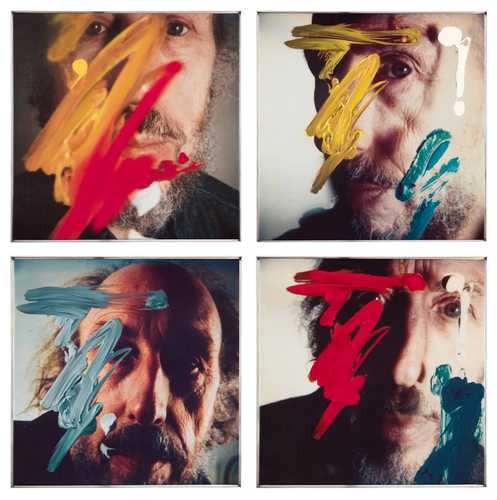
Quiz: Which Pop Artist Are You?

Who is Andy Warhol?
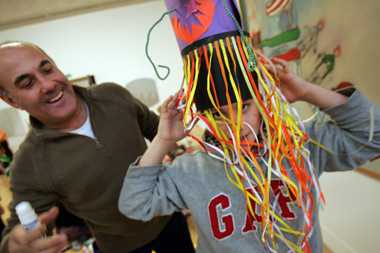
Make a Pop Art Hat

Make Pop Art like Warhol

IMAGES
VIDEO
COMMENTS
Pop art is an art movement that emerged in the 1950s and flourished in the 1960s in America and Britain, drawing inspiration from sources in popular and commercial culture. Different cultures and countries contributed to the movement during the 1960s and 70s. Emerging in the mid 1950s in Britain and late 1950s in America, pop art reached its ...
Art historian Robert Hughes series - episode 7 - Culture as Nature. British historian Alistair Sooke tracks down the forgotten women artists of pop, finding their art and their stories ripe for rediscovery. Artists include Pauline Boty, Marisol, Rosalyn Drexler, Idelle Weber, Letty Lou Eisenhauer, and Jann Haworth.
Pop art was a descendant of Dada, a nihilistic movement current in the 1920s that ridiculed the seriousness of contemporary Parisian art and, more broadly, the political and cultural situation that had brought war to Europe. Marcel Duchamp, the champion of Dada in the United States, who tried to narrow the distance between art and life by celebrating the mass-produced objects of his time, was ...
This gathering of young painters, sculptors, writers, architects, and critics hailed in the new Pop Art movement. This group of artists began meeting regularly in the 1950s and their discussions would center around developments in technology and science, the found object, and the place of mass culture in fine art.
Pop art's origins, however, can be traced back even further. In 1917, Marcel Duchamp asserted that any object—including his notorious example of a urinal—could be art, as long as the artist intended it as such. Artists of the 1950s built on this notion to challenge boundaries distinguishing art from real life, in disciplines of music and dance, as well as visual art.
With 503 contributors from 201 colleges, universities, museums, and research centers, Smarthistory is the most-visited art history resource in the world. For Learning. ... In contrast to the dripping paint and slashing brushstrokes of Abstract Expressionism—and even of Proto-Pop art—Pop artists applied their paint to imitate the look of ...
A movement comprising initially British, then American artists in the 1950s and 1960s. Pop artists borrowed imagery from popular culture—from sources including television, comic books, and print advertising—often to challenge conventional values propagated by the mass media, from notions of femininity and domesticity to consumerism and patriotism. Their often subversive and irreverent ...
Leo Castelli, who is to be one of the great promoters of Pop Art, opens his gallery in New York. 1958. First solo exhibitions by Jasper Johns and Robert Rauschenberg at the Leo Castelli Gallery in New York. 1960. Andy Warhol does his first paintings based on cartoons: Dick Tracy, Superman, Popeye ...
Think again! Andy Warhol, Roy Lichtenstein, soup cans and multiple Marilyn Monroes are just part of the story. Far from being purely an American art phenomenon, pop art spanned the globe. The1950s and 60s may have been a time of economic growth in America, but they were also decades of social upheaval and unrest around the world.
A particularly interesting area of exploration, which arose from the work within the exhibition, is the complex relationship artists have with photography and processed imagery, which we can explore through three major works from the exhibition. Richard Hamilton, Swingeing London 67. Swingeing London '67 1967-1968. Pallant House Gallery.
Abstract. Pop art originated in Britain in 1950, became popular in the United States in the 1960s, and then spread to Italy, Japan and other countries. It pulled art from the high altar ...
Andy is known as a Pop Art designer since he created works with mass printing techniques. Through his movement, he successfully represented his social criticism against the power of capitalism ...
'The artistic movements of pop art were defined as popular, young, witty, sexy, and glamorous. (a quote from the website of original style , an online tile shop)' The appearance of pop art in Britain and the United States in the mid 1950 and ... Biological Rhythm Research. The effect of exogenous HSP70 on expression kinetics of HSP70, TLR2, and ...
Modernism, Postmodernism, and Pop Art The sources studied in the scope of this research have revealed a necessity to clarify the meanings of Modernism and Postmodernism due to the overt counterpoising of popular culture against high and minoritarian a t, a d of ass ultu e agai st elitist a t.
Tate Papers (ISSN 1753-9854) is a peer-reviewed research journal that publishes articles on British and modern international art, and on museum practice today. Examining the technical and symbolic impact of pop art on the posters produced at the Atelier Populaire during the events of May 1968 in France | Tate Papers no.24.
Roy Lichtenstein. American Painter, Sculptor, and Lithographer. Born: October 27, 1923 - New York, NY. Died: September 29, 1997 - New York, NY. Pop Art. Postmodernism. "I'm never drawing the object itself; I'm only drawing a depiction of the object - a kind of crystallized symbol of it." 1 of 7.
pop art has a far -reaching impact on the development of modern architectural forms. to a. certain extent, pop art breaks the boundary betwe en art and life in a relaxed and playful popular. way ...
Find the latest published documents for pop art, Related hot topics, top authors, the most cited documents, and related journals. ... The research methodology involves recourse to an interdisciplinary approach, as well as the use of comparative, historical and logical methods of analysis and culturological approach in the study of these issues. ...
Abstract Expressionism famously shifted the center of the advanced art world from Paris to New York. The triumph of Abstract Expressionism, and its subsequent abrupt decline in the face of Pop Art, are familiar tales in the literature of art history. Econometric analysis of evidence from auction markets now provides a basis for dating precisely ...
Tate Modern is ready to tell a global story of pop art, breaking new ground along the way, and revealing a different side to the artistic and cultural phenomenon.. From Latin America to Asia, and from Europe to the Middle East, this explosive exhibition connects the dots between art produced around the world during the 1960s and 1970s, showing how different cultures and countries responded to ...
Abstract. Under the influence of the information age, modern architecture tends to develop in a diversified direction. Pop art, which was born in the middle of the 20th century, is the product of a specific historical period. the popular, grotesque and playful art form shown by pop art has a far-reaching impact on the development of modern ...
Pop Art. Bold, bright and brash! Find out more about pop art. Share. Find out what is pop art with this art homework guide, includes facts for kids about Andy Warhol and Roy Lichtenstein comic book art.